

IN GOOD COMPANY Toasting 2022’s Brands of the Year: Heinz, Mastermind Toys, CDSS, Zabiha Halal and BRP WIENER TAKES ALL Rethink reigns as agency top dog FALL 2022 • $6.95 CANADA POST AGREEMENT NUMBER 40050265 PRINTED IN CANADA USPS AFSM 100 Approved Polywrap A PUBLICATION OF BRUNICO COMMUNICATIONS LTD.
Luxury
Brands
Agency of

ON THE COVER: OK, so here’s the thing. We talk about hot dogs a lot this issue. Probably more than a serious marketing publication should. (Well, there are a few mentions of sausages, too, but we managed to keep those to a minimum. We still have our pride.) But, really, we blame Rethink. And Heinz. (One of our brands of the year and a double campaign of the year winner.) We just report the news. They’re the ones turning hot dogs into a serious topic of conversation around the boardroom tables of the nation. But, not ever wanting to surrender the high ground, we went one better. We turned hot dogs into art –
art by illustrator Graham Roumieu. Your move, Rethink. Your move.

cover
IN GOOD COMPANY Toasting 2022’s Brands of the Year: Heinz, Mastermind Toys, CDSS, Zabiha Halal and BRP WIENER TAKES ALL Rethink reigns as agency top dog 2022 $6.95 AGREEMENT PRINTED 100 Approved PUBLICATION BRUNICO COMMUNICATIONS LTD.
Retail Canada's high-end labels might be prepping for a possible economic downturn, but they're surprisingly serene.
of the Year Heinz, Mastermind Toys, Canadian Down Syndrome Society, Zabiha Halal and BRP all found impressive ways to break through.
the Year We name our top agencies of the year –including some familiar faces and plenty of new contenders. 4 Editorial Are we really ready for virtual reality Teams meetings? • 6 Upfront Check out our holiday marketing guide, catch up on our biggest stories of the year, and see how some are reacting to the pending recession • 26 Indigo turns 25 Follow the evolution from book seller to comprehensive lifestyle brand • 80 Strategy Awards We give our knowing nod to the best work of the year 11 338 3Fall 2022
Broken Heart Love Affair won Small Agency of the Year gold thanks to campaigns like this one for The Royal Ontario Museum. See all our AoY winners starting on page 33.
FALL 2022 • VOLUME 33, ISSUE 4
Investing in people, not avatars
Iwas among those who spent a whole afternoon in September with a perplexed look on their face while Meta gave its latest presentation on its vision for the metaverse.
Most of the people in the social media popcorn gallery were cracking jokes about Mark Zuckerberg finally figuring out the science behind adding legs to avatars, but my confusion came from a different reveal: a new partnership with Microsoft on virtual reality Teams meetings.
There’s a few questions I think needed to be asked in that boardroom: in a time when it’s hard enough to get everyone in a meeting to turn on their webcam, would it be any easier to convince someone to strap a headset on for long enough to give them motion sickness? Or, would employees feel more engaged if the $500 spent on getting them a Quest headset was spent on a bonus instead? And, the most important question of all: who asked for this?
Despite how much they’ve been talking about “the future of work” and listening to the needs of employees, it seemed like another example of business leaders being supremely out of touch. They are enraptured by the shiny new thing without taking a beat to consider if anyone actually wants it. “Surely,” they seem to have thought to themselves, “my staff will think this is as neat as I do, and not something their boss is forcing on them as they would overtime on a Friday evening.”
Thankfully, looking at some of our Agency of the Year winners shows that at least a few companies have clued in to a simple truth: work is tough these days, everyone is stressed and busy, but there are things that can make people feel appreciated for what they do.
The winners were evaluated based on their output, but you don’t create an AOY-worthy body of work unless you’ve figured out how to hold on to your talent.
Yes, sometimes that means a raise or flexible work – given the cost of living and our current lifestyles, those are table stakes now. But for some of our winners, it also means providing mental health support that isn’t “one size fits all.” Others are rethinking mentorship and professional development. One has even invested heavily in a workplace that is purpose-built to keep people energized and – gasp – exists in the real world. Others still just offer the opportunity for staff to have their ideas be heard.
The thing they all have in common, though, is the recognition that talent is something to be invested in, not a commodity that churns through a revolving door. And if you’re going to stay on top of your game, you have to listen to what your staff want, instead of letting the hype decide for them.
Josh Kolm News Editor, strategy
fall 2022 volume 33, issue 4 strategyonline.ca
publisher | lisa faktor | lfaktor@brunico.com
content director, editor | jennifer horn | jhorn@brunico.com (leave)
interim editor | brendan christie art director | tim davin | tdavin@brunico.com
associate editor | chelsea clarke | cclarke@brunico.com
associate publisher | neil ewen | newen@brunico.com news editor | josh kolm | jkolm@brunico.com
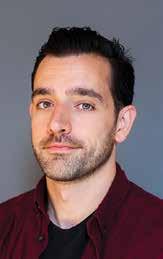
senior reporter | justin crann | jcrann@brunico.com
senior reporter | chris lombardo | clombardo@brunico.com
contributing writers | brennan doherty, nick kewen, loukia papadopoulos, patti summerfield, will novosedlik account manager | nupur purohit | npurohit@brunico.com marketing co-ordinator | emily yuill | eyuill@brunico.com
CORPORATE
president & ceo | russell goldstein | rgoldstein@brunico.com evp, canadian media brands & editorial director | mary maddever | mmaddever@brunico.com director, finance & administration | michelle plaskon | mplaskon@brunico.com creative services & dist. manager | adriana ortiz | aortiz@brunico.com customer support supervisor | christine mcnalley | cmcnalley@brunico.com
how to reach us Strategy, 366 Adelaide Street West, Suite 100, Toronto, Ontario, Canada M5V 1R9 Tel: (416) 408-2300 or 1-888-BRUNICO (1-888-278-6426) Fax: (416) 408-0870 www.strategyonline.ca
customer care
To order a subscription, visit strategyonline.ca/subscribe. To make a change to an existing subscription, please contact us by email: strategycustomercare@brunico.com. Tel: (416) 408-2448 Fax: (416) 408-0249. 8799 Highway 89, Alliston, ON L9R 1V1.
subscription rates
STRATEGY is published five times per year by Brunico Communications Ltd. In Canada: One year CA$80.00 Two years CA $144.00 (HST included. Registration #856051396 RT)
Single copy price in Canada is CA$6.95. Please allow four weeks for new subscriptions and address changes.
copyright and trademark
STRATEGY and the tagline “Bold vision brand new ideas” are trademarks of Brunico Communications Ltd. All rights reserved. Nothing may be reproduced from STRATEGY in whole or in part without written permission. Reprint requests should be sent to rgoldstein@brunico.com. © 2018 Brunico Communications Ltd.
postmaster notification
Canadian Postmaster, send undeliverables and address changes to: Strategy, 8799 Highway 89, Alliston, ON L9R 1V1 strategycustomercare@brunico.com U.S. Postmaster, send undeliverables and address changes to: Strategy PO BOX 1103 Niagara Falls NY 14304 Printed in Canada. Canada Post Agreement No. 40050265. ISSN: 1187-4309.
Member of
4 strategyonline.ca
EDITOR’S NOTE IF YOU’RE GOING TO STAY ON TOP OF YOUR GAME, YOU HAVE TO LISTEN TO WHAT YOUR STAFF WANT, INSTEAD OF LETTING THE HYPE DECIDE FOR THEM.
LETTER













Dear ,




your soon-to-be ex-boss
Please accept this letter as formal notification that I am resigning from my position at in the . I’ve decided to pursue a new opportunity at Zulu Alpha Kilo.
your current agency
department you’re ecstatic to leave brand you didn't win
The truth is, I’m sick of working on spec creative pitches every weekend. The work I did on the pitch will never be seen outside of that -page deck.
unnecessarily large number number less than one A) Nothing B) Squat C) Bupkis
The late nights I spent on the global creative brief for resulted in me adding pieces to my portfolio and did for my career.
Also, having to fill out a form whenever I needed a box of was pointless.
brand who never saw your work adverb; bonus points for profanity


And I never understood why my raise had to be approved by in New York, who previously didn’t know I existed.
I’m feeling to be joining an independent agency that’s not afraid to challenge outdated industry norms.
Thank you for the opportunity to . My last day will be .
Sincerely,
office supplies under $10 your emphatic signature
global big wig who makes eight figures expression of unbridled joy say one nice thing date that can’t arrive soon enough
Want to work at Zulu Alpha Kilo? Just ll in the blanks. We’re always on the lookout for the best talent across all disciplines. If you’re ready to do more of what you love with fewer holding company handcuffs, apply at GetMeOutOfThisJob@zulualphakilo.com
OF RESIGNATION
Above: Some brands, such as Real Canadian Superstore, are taking an indirect approach to speaking to rising costs.
THE INFLATED ELEPHANT IN THE ROOM
By Justin Crann
DASHING THROUGH THE SALES
By Chelsea Clarke
If you’re like us, the last thing you want to hear about marketing for the holidays is that we’re “embracing the new normal” or that “shopping looks a little different this year.” Been there, done that.
The fact of the matter is, and we’re sorry to do this to you, but the new normal of this holiday season is an honest-to-goodness first of its kind. Consumers are flocking to in-store shopping once again, and it doesn’t look like a looming wave of Covid-19 will disrupt family get-together plans (knock on wood).
Inflation may be slowing, but that hasn’t eased pressures on Canadian consumers, as the price of certain essentials – perhaps most notably, groceries – continue to climb. Those rising costs are creating interesting challenges for marketers vying for shares of Canadians’ increasingly tight budgets.
For some brands, a subtle approach was in order.
Real Canadian Superstore is one such example, taking visual inspiration from another typically tactical marketing vehicle – its flyer – and using the look to deliver a more emotionally resonant message about savings and value shopping. In the ad developed by 123w, everyday Canadians were depicted getting up to common activities, while graphics showed how various Superstore programs and offers could help them stretch their dollars and meet the demands of their lives.
The Superstore ad never directly mentions inflation, but of course, that might be the point. While there can be an instinct to tackle tough topics directly, many marketers will balk because – as seen during the COVID-19 pandemic – consumers become exhausted when reminded about the hard times they are facing.


Others, however, threw caution to the wind.
Consider Pizza Pizza, which decided to tackle the topic head-on with its “Fixed-Rate Pizza” campaign, developed with agency partner Zulu Alpha Kilo. The messaging was a pivot from what Adrian Fuoco, the QSR pizza brand’s VP of marketing, says is its more typically tactical marketing, aiming to appeal to consumers’ feelings around inflation and the rising cost just to keep everyone in the household fed. It especially targeted families, who have more mouths to feed and thus are feeling the pinch more than most.
It’s tough to tell precisely how successful the campaign has been – at least before the QSR chain’s quarterly results come in – but, if nothing else, it certainly generated its fair share of buzz, snagging headlines on outlets including Bloomberg and mentions in publications including the Globe and Mail, and considerable play across social media.
Assuming just a fraction of that attention translated into pizza sales? Well, as they say –that’s amore.
There are other matters to tend to, though. Brands are questioning where to place their investments to win over consumers in the holiday marketing race. With so many factors to consider, from the changes consumers are making to their purchasing habits, to the desire to return to an in-store shopping experience, and a general messaging overload that’s to be expected this time of year, just how can a brand ensure its marketing will be heard and its investments will make a difference?
We consulted Laura Richard, principal at Level5 Strategy to help us navigate seasonal marketing in real-time.
INFLATION LOOMING
As we manoeuvre rising costs and the potential “R-word” on the horizon, there’s pros and cons to consider when determining just where to place investments for holiday marketing. But Richard says timing may be the most important factor. “Consumers are already watching their wallets,” she says. “With this in mind, brands should think about getting creative promotions out early
6 strategyonline.ca
to break through the noise and capitalize on the fact that customers are now conditioned to promotions and shopping events at any time of year.”
E-COMMERCE DIPS
Growing weary of living their lives online, we’re seeing a dip in e-commerce as consumers answer the siren call of bricks-and-mortar. But Richard says there’s an opportunity to create a completely new online experience that far outweighs what we’ve previously seen. “I’m seeing brands bridge in-person activities with digital sales channels. For example, high-touch experiential activations that drive e-commerce platforms,” she says. “This starts to take unified commerce to the next level by leveraging each channel in an optimal way and allowing consumers to choose their own ideal path to purchase.”
STRATEGY’S MOST-READ STORIES OF 2022
By Josh Kolm
SET THE TONE
Funny? Heartfelt? Nostalgic? It’d be easier if consumers just told us what they want… but here’s what Richard predicts: “The tone of marketing will have to be careful to consider the issues of the day and where consumer sentiment is sitting,” she says. “I believe the challenges facing households and the negativity we continue to be bombarded by in news cycles leave consumers craving empathy, connection and authenticity in holiday marketing. While collectively, society is craving a return to normal, holiday 2022 can’t be considered business as usual, so an approach that acknowledges this will be important.”
SKIP POPS WITH KATY PERRY SkipTheDishes ended its series of ads starring Jon Hamm last year, but 2022 saw the brand and AOR McCann make sure it didn’t lose its star power.
It began early in January with Snoop Dogg, but readers were even more interested in the summer campaign with Katy Perry. It featured the pop star singing about “sushi and a movie” and “subs in the tub” amid vivid colours and over-the-top outfits that made it feel more like a music video than an ad.

ROGERS SHUTTERS THEO
In March, Rogers dissolved Theo, a dedicated agency WPP had created in 2020 by pulling in talent from John St., Taxi and Mindshare. While Mindshare retained the company’s media duties, creative was moved to Sid Lee, though Taxi did retain its previous work on the Fido brand.
But there were to be other changes in store for the company in 2021. Simone Lumsden – CMO when WPP pitched Theo – was one of several executives who left the company during what can only be described as a tumultuous year.
RETHINK PARTNERS MAKE A “COURAGEOUS” EXIT Spring is about changes and new starts, and this year that was especially true after creative partners Joel Holtby and Dhaval Bhatt left Rethink along with business lead Niki Sahni.


The trio would later launch Courage, a new agency backed by Dave Lafond and Serge Rancourt, who had previously created No Fixed Address. Since opening its doors in May, Courage has picked up AOR assignments with CIBC and North York General Hospital, as well as attracted Ogilvy’s Tom Kenny as its chief strategy officer.
JOHN ST. UNVEILS ITS NEW EXEC TEAM
Stephanie Hurst left her job as John St.’s CEO at the end of June, but it wasn’t before helping the agency set up an executive team to guide the agency into the future.
The new leadership included Allison Ballantyne, promoted to president, and Matt Ball, who had been hired from Wunderman Thompson as chief strategy officer (previous CSO Megan Towers left the agency the month prior). The leadership also included a trio of existing John St. execs: CCO Cher Champbell, chief delivery officer Cas Binnington and Tishan Canagasaby, EVP of account management.
SANTA PHOTO: DIMA D/PEXELS
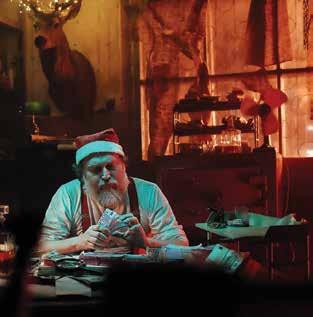
7Fall 2022
Left to right: Holt
Renfrew has worked with influencers like Mustafa the Poet (far left) to reach new demos, while Harry Rosen has launched bespoke line Harold (center) and FinalCut (far right), an online destination aimed at the younger buyers, to target new audiences.
Luxury retailers approach recession
Back in 2008, the world was hit with the worst financial crisis it had seen since 1929. But, instead of folding, the French holding corporation specializing in luxury goods, LVMH, spent most of the period preparing for what came after. It cut back on marketing budgets at a time when demand was low and saved cash reserves for bigger inventory buys when demand returned.
Now, as inflation is once again causing prices to skyrocket, luxury retailers are taking a page from that same playbook and staying cool, calm and collected as they insulate themselves against recessionary pressures.

Prada is investing in its supply chain and distribution networks as a way to strengthen itself against uncertainty. Kering, which owns Gucci, is relying on price increases to ride out the storm. Still others, like outerwear label Moncler, aren’t seeing a downturn and it’s business as usual.
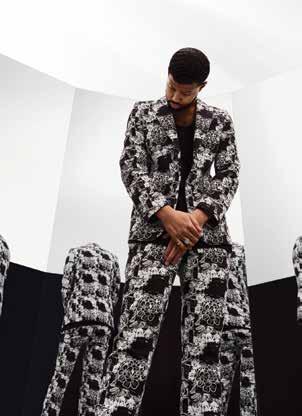
Harry Rosen president and COO Ian Rosen is also not over-reacting. “Coming out of the last few years, especially in Canada where we just opened up in March and have really only started to see things kick into full swing, it seems like life is going back to something resembling normal,” he says. “That’s helped us get much closer to our numbers and much closer alignment between buying, planning, marketing and sales. I think as we look ahead, it’s all about making sure that we’re not overreacting, and managing our way through any areas of exposure.”
Rosen, like Moncler, says he is not feeling the recession yet either. He believes there are pentup demand drivers that are going to keep people shopping, even in an inflationary and possibly recessionary period. “Things like going out for dinner, or going on a trip, or having that cocktail party coming up that you haven’t been to in a few years, those are all key demand drivers for people to shop with us. And

8 strategyonline.ca
with a level head
BY WILL NOVOSEDLIK
those don’t seem to be going anywhere,” says Rosen.
For his part, Wes Wolch, senior vice president of marketing at Holt Renfrew, is partly banking on his vendors to do some of the heavy lifting if things soften. “If Prada is looking to invest in their supply chain to ensure that there is more efficient and effective delivery of their product, that’s a benefit to Holt’s and our customers as well. The thing that we always want to look for is where the synergies are with the brands that we carry. There are levers that are within our control, levers where we share control, and then there are levers outside of our control.”
When it comes to things under his control, Rosen talks about taking calculated risks. “One of the key learnings through the pandemic is you can feel like you’re in an inventory crunch, but it depends on the mix. We have some safe bets. And we’re not restricting or cancelling anything, we’re beefing up in the right areas.”
So, what about discounting? Rosen says no: “That’s not the game we like to play in our main chain.” But the complement of what Harry Rosen is going to market with today versus three years ago is much different. The brand has entered a number of

new categories, like sportswear and personal care, and is about to do a big push into “lifestyle’” – think of things like home and office merchandise. Being able to address more usage occasions is one of Harry’s ways of keeping relevant.
While Harry eschews discounting in its main chain, the brand’s recent launch of FinalCut, an online destination aimed at the younger buyer, is not only helping sales but attracting a new client.

Holt’s can draw the younger, less wealthy client with smaller purchases, says Wolch. He notes that the brand doesn’t view itself so much as a luxury store but as a lifestyle experience. “If you’re looking for a Versace coat for your dog we have those,” he says. “But if you’re just looking for a great looking bowl and leash, we’ve got those too. You might not be able to buy that Chanel handbag, but you can afford Chanel lipstick to put in your handbag. It’s the evolution from just being about luxury to being about style that’s keeping us relevant at every price point.”
GAINING INFLUENCE
Another way to stay relevant is with influencers. Holt’s, for example, worked with Sudanese-Canadian poet, singer, songwriter and filmmaker Mustafa the Poet, famous for his poems and songs about the inequities of Toronto’s Regent Park neighbourhood where he grew up.
“Our mission at Holt’s is to empower self-expression and ignite positive change,” notes Wolch. “Mustafa is a famous example, but we also work with influencers in the worlds of science, technology, journalism and design. For us, it’s about how they align with our mission and connect with the community that we’re trying to reach.”
Harry Rosen worked with influencers to launch its private label, Harold. Says Rosen, “It has a fantastic ready-to-wear offering complemented by a custom-made program. We collaborated with a group of influencers to build them a great outfit and walk their followers through the experience. There’s some extremely talented people out there who know how to build very compelling, quick-hit content as part of our strategy moving forward.”
As e-commerce continues its reign, luxury retailers insist there’s still a place for bricks and mortar. After being locked up for so long, there’s pent-up demand among Canadians for the instore experience. Harry is expanding its outlet footprint, having opened at McArthurGlen in Vancouver and soon opening at the CrossIrons Mills in Calgary. Likewise, Holt’s recently opened its fully renovated Montreal flagship, which Wolch claims stands toe to toe with global banners like Selfridges, Neiman Marcus and Galeries Lafayettes.
So, as retailers and consumers ponder whether the recession will hit or not, Canada’s homegrown luxury retailers are approaching the potential downturn with a steady hand, placing calculated bets and managing all the levers at their disposal with discipline. As Wolch says, “We hope for the best, but plan for the worst.”
A version of this story appeared in Strategy’s C-Suite. For more, visit strategyonline.ca/category/c-suite
9Fall 2022
clap.
to our partners at Heinz Ketchup for being named
Brand of the Year.

SLOooooW
Congratulations
a strategy
BOY 22BRANDS OF THE YEAR
EWith every year that passes, it feels like it’s getting a little noisier. The dial gets turned up: sometimes a little, sometimes a lot. There’s more media, more platforms, more news, more drama, more… well, everything. Yet, somehow, there are still brands and messages that break through, that stand out from the madding crowd despite the growing chatter. So, every year strategy sets aside space to recognize those brands that have found new and innovative ways to connect –building momentum as they go to achieve big success this past year – our Brands of the Year. The five companies that topped the list this year didn’t react, they led. Even in the face of social and economic uncertainty, they took hold of the narrative and spoke deeper truths. Heinz proved that even established brands can find new and meaningful ways to engage with consumers; Mastermind Toys grew in the face of a global pandemic by embracing play on all its channels; Canadian Down Syndrome Society relied on research to change the narrative and tear down stereotypes; Zabiha Halal found success by speaking with the authentic voice of a community; and, finally, BRP made it all about resonant stories powered by real experiences. So, in no particular order, here are our picks for strategy’s Brands of the Year. And what a year it was.
11Fall 2022
Heinz redefines what it means to be iconic
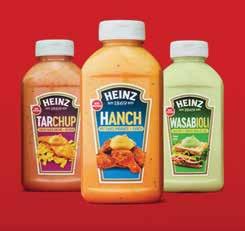 BY CHELSEA CLARKE
BY CHELSEA CLARKE
doesn’t rest its clout and call it a day. In fact, its marketing has evolved in a way we’d bet most consumers wouldn’t expect. After all, when’s the last time a ketchup campaign made you laugh out loud?

Weirdly, that’s now a question most Canadians can answer. Over the last few years, Heinz’s ketchup campaigns, in partnership with agency Rethink, have been witty, sarcastic and culturally on point. Standout campaigns have made us laugh, gotten us (and our U.S. counterparts) talking and even changed how hot dog buns are packaged (more on that later). All the while, Heinz has stayed true to its roots, used self-deprecation to its advantage and reminded us that there’s still a place for levity, even after a somewhat tumultuous couple of years.

Don’t kid yourself that this was by mistake, either.
“Our iconic brands require more than traditional advertising to solve business challenges and connect with consumers in new and meaningful ways,” says Kraft Heinz’s chief growth officer Diana Frost. “At Heinz, we continue to reinvent these deeply nostalgic brands via a modern lens, so they can evolve and further cement themselves as cultural icons.”
Heinz’s heavy hitting campaign, “Hot Dog Pact,” was arguably the brand’s main squeeze of the year. Dripping in tonguein-cheek humour, it outlined the travesty that is hot dogs coming in packs of 10 while buns are packaged in eight. Taking a stand against “big bun,” the social-led rally cry launched in the summer with a video outlining the issue and asking consumers to take action by signing the Heinz Hot Dog Pact on Change.org. The petition gained 15,000 signatures in the first 24 hours alone, with food and lifestyle influencers spreading the message far and wide.
TThere are two kinds of icons: those that are a flash in the pan, and those that stand the test of time. If you’re the latter, you’d better embrace reinvention – sometimes over and over and over again. (Madonna, we’re looking at you.)
In the CPG category, Heinz ketchup is an icon in tomato form. From the brand’s inception in 1869, delivering quality products stood out as the company’s North Star. Once ketchup was introduced to the line-up in 1876, it only took a few decades before the manufacturer was named the world’s largest tomato processing company. But while the recognizable bottle shape and signature slow-pour of Heinz ketchup has been a staple in Canadian households since most of us can remember, the brand
With the help of PR agency Middle Child, “Hot Dog Pact” hit a whopping $13MM in earned media with over 1.2 billion earned impressions. Overall sales increased by 2.3% from 2019 and shares increased by 1% in the ketchup category. Maybe best of all, though, Wonder Bread folded and announced the brand will be selling buns in packs of 10.
12 strategyonline.ca
Never thought we’d say this, but we’re obsessed with ketchup this year.
Opposite: Heinz made its mark this year by motivating consumers to right wrongs (the travesty that is the 10-bun hot dog pack!) and innovate new product offerings (via “crowdsaucing”).
Above:
While the iconic brand is traditionally known for its slow-pour anticipation, Heinz’s latest campaigns, in partnership with agency Rethink, have been witty, sarcastic and culturally on point.
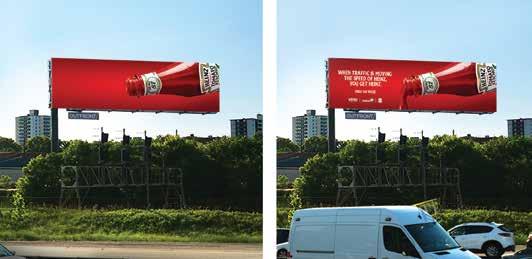
Mike Dubrick, Rethink managing partner and ECD, recalls the moment he knew the campaign had arrived. “The best is when you get a message from outside Ad Land from the people who experience the work in the wild,” he says. “’Hot Dog Pact’” was featured on U.S. pre-market business news show, The Squak, and a friend in finance randomly shared it. We knew we were onto something then. Fast forward a few months later and we’re on the phone with Wonder Bread and Heinz making 10-bun packs a reality.”
“Hot Dog Pact” wasn’t the only campaign that relied on the power of social media to amplify its reach. After successfully launching Maychup (mayo + ketchup) and Mayracha (mayo + Sriracha) in 2018 and 2019, Heinz was on the hunt for a new way to drive sales and conversation by way of mash-ups.
Instead of polling consumers directly, “Crowdsauced” was born,
iconic Heinz bottle, and “Bottleneck,” which partnered with Burger King and Waze – continue to solidify Heinz’s reigning champ status.
“Heinz is a pop culture icon,” says Dubrick. “But to maintain that status, it necessitates work that puts the brand into the mainstream press, in conversation at parties, or in the car with an Uber driver.”
“We’ve been focused on driving brand relevance and brand love by prioritizing connecting with consumers through cultural context. We want to engage fans with iconic, clever creative that pushes beyond traditional marketing and breaks through the constant stream of content that is today’s norm,” adds Frost.
Marketing outside-the-box has paid off, reinforcing Heinz’s place in consumers’ shopping baskets, and the brand has seen success in building engagement with its consumers and loyal base of followers on its owned channels. “For Heinz ketchup, our leading household penetration across North America has steadily grown more than two points versus 2019, taking into account the extenuating factors of the last few years,” Frost notes.
And for Heinz and CPG as a whole, those factors continue to extenuate. But, despite inflationary pressures, Heinz has delivered nine consecutive quarters of growth with solid momentum, managing with a combination of efficiencies and pricing, as well as providing customers with value beyond price: Frost points to the comforting act of enjoying a bowl of Kraft Dinner and Oscar Mayer hot dogs smothered in ketchup – for less than one dollar per serving.
and Heinz took to social media to see what condiment concoctions people had already been talking about. After reviewing hundreds of posts on forums, groups and subreddits, Heinz launched Tarchup (tartar sauce + ketchup), Hanch (hot sauce + ranch) and Wasabioli (wasabi + aioli), along with social campaigns that told the origin story of each sauce and introduced its creator.
“Crowdsauced” was the ultimate online “creeper” campaign –and Heinz knew it. The brand launched videos that unabashedly explained how it had sneakily stalked old posts, and the campaign was extended onto YouTube with Google’s Director’s Mix, allowing the brand to target hundreds of specific audiences with custom ads for each sauce.
In total, the new sauces added $820,000 worth of product sales and accounted for 1% market share of the total Viscous category. (Sales were also 46% higher than for Mayoracha, the brand’s previous mash-up.) Overall, the campaign generated over sixhundred million earned impressions and coaxed Heinz into creating a second run of the products, which wasn’t part of its original plan.
These and other campaigns – such as “Draw Ketchup,” which asked people to draw ketchup that would inevitably look like the
Even with the uncertainties of the economy, Heinz plans to dominate. “We continue to drive our long-term strategy of expanding our footprint through acquisitions and partnerships where we can leverage our scale, and in turn, garner new capabilities for the company,” says Frost.
An example of this is the recent partnership between Heinz and NotCo, a food-tech company that uses machine learning to replicate dairy products into plant-based forms. The co-branded plant-based food products combine the power of NotCo’s patented A.I. platform and Heinz’s product portfolio and scale. The partnership provides Heinz leverage as a key player in the plant-based food space, giving the brand the ability to diversify its offerings to a consumer base that’s increasingly interested in alternative options.
So, what’s next for Heinz after a year that turned the world of marketing upside down? “Looking to the future, we want to be a leading brand in culture, not just among CPG brands,” says Frost. “We’ll continue building on our iconic status and driving relevance and affinity with our consumers to cement Heinz’s status as a beloved household brand and global cultural icon.”
13Fall 2022
BOY 22
Have you sparked innovative experiential, activation or retail ideas that ignited action in the shopperverse? Take credit for your work. Entry deadline: Nov. 18 shopperinnovationawards.strategyonline.ca [ ]
Mastermind Toys ups its game
BY CHELSEA CLARKE
While some brands white-knuckled their way through the pandemic, Mastermind Toys saw every new challenge as an opportunity for success and reinvention.

Mastermind Toys’ CEO Sarah Jordan had just started her tenure as the pandemic set in, and she knew that she’d need to make every decision count. Initially, she decided to temporarily close Mastermind Toys’ 68 stores coast-to-coast before government mandates came into effect. But, while other brands had already an established online presence to fall back on in the interim, that wasn’t the case for Mastermind Toys.
“Our digital offering was severely lagging in the industry – representing less than five percent of our total sales pre-pandemic. There was a big opportunity for
us to innovate our online experience,” she says.
And innovate it did. Mastermind Toys has a reputation for having an untouchable in-store experience – from its knowledgeable store associates (deemed Play Experts), to its in-store demos, larger-than-life displays and free signature gift-wrapping (that’s designed in Canada). Jordan was unwilling to sacrifice the brand’s wonder as she moved the platform online.
With plans already in the works to bring the in-store experience online, the pandemic only accelerated Jordan’s strategy. The company designed new critical functionality to navigate retail restrictions, such as its buy-onlinepick-up-in-store model, as well as a new website that laid the foundation for the brand’s enhanced digital ecosystem.
Now, Mastermind Toys is an award-winning omni-channel retailer. “Our web and store experiences complement, not compete against, each other,” she notes. “Externally, this initiative looked like a website relaunch; internally, it required a cultural transformation so that the brand would think equally about digital and in-store experiences.”
In stores, Mastermind Toys created “WooHoo HQ” desks, dedicated spaces for digital and curbside that customers can use as fast lanes to pick up orders, make any changes or add-ons to their purchases and have their orders gift-wrapped. “Online, we bring our specialty experience to life through AI-powered search functionality, wish list feature and seasonal play guides,” says Jordan. “We’ve become so much more than a bricks-andmortar toy store. I believe there’s gold at the intersection of digital and physical.”
At-the-ready for whatever came her way, Jordan also wanted to make sure the brand and its teams remained steadfastly true to its longterm strategies. She created three cultural goals in 2020 for her teams that would lead the way: Be bold and scrappy; create momentum to come out of the pandemic stronger; and keep what makes Mastermind Toys special.
Now, those goals have evolved into five core company values: customer obsession, action, performance, inclusivity and having fun. These guidelines harness the power of what Mastermind Toys stands for: That it’s not just a holiday store –it’s Canada’s “authority on play.”
This sentiment is something Jordan takes seriously, and weaves throughout the entire
15Fall 2022
The toy and children’s book retailer seized the moment by strengthening its digital, cultural and marketing strategies.
W
company. For Mastermind Toys, the goal is not to simply deliver toys, books, puzzles and games to kids and “kids-at-heart” (company lingo for “adults”), but to truly embody its positioning as understanding how integral play is to growth development.
Mastermind Toys has a trademarked curation model, “Why Kids Play,” which is the basis for how its merchants select every toy or book on offer. The model describes how different play patterns support development at each age and learning stage, which establishes the brand as one of the only juvenile retailers in the world that curates based on outcomes of play rather than gender. The brand is also committed to including kids from all backgrounds and abilities in its marketing and content to drive home where its focus stands: That play is inclusive and unanimously enjoyed by all.
In December 2021, Mastermind Toys packaged this mission into its first-ever brand-centric campaign, “Let’s Play,” created in partnership with Toronto-based The Local Collective. The 30-second spot features kids from all walks of life coming together outdoors to discover the power of play. “We knew this was the moment for us to create our first-ever brand ad to strengthen our position as Canada’s authority on play – a global category leader whose unique value proposition is that we know play better than anyone else – as Canadians were reinventing the ways they play by turning their backyards into recess yards,” says Jordan.
Driven by the ambition to position itself as a year-rounddestination retailer, with “Let’s Play” Mastermind Toys sought to unleash Canadians’ desire to play through all seasons by sparking curiosity, learning, discovery and wonder. The message resonated with customers, employees and the industry – “Let’s Play” won the Retail Marketing award at the 2022 Excellence in Retailing Awards by the Retail Council of Canada.
As Mastermind Toys’ strategies paved the way to learn, pivot and ultimately thrive through the pandemic, Jordan faces a new set of challenges that lie in its wake. Amid recession, inflation, supply-chain complications and staffing shortages, Jordan holds her head high.
“We prepared for this reality in 2021 and have continued to mitigate the challenges we’re all facing in a few ways,” she says. She points to the company’s now streamlined omni-channel experience as a way to give customers more flexibility in how they shop across the brand’s platforms, as well as prioritizing inventory flow by introducing more supplier options.
When it comes to staffing shortages as the company dives into a busy holiday season, Jordan isn’t worried – Mastermind Toys is a master class in a positive culture that keeps seasonal workers coming back. “Especially leading up to the holidays, we can increase our Play Experts by up to 80%,” she says. “In the 2021 holiday season, over 75% were returning staff, and we expect the same for 2022.”
Earlier this year, Mastermind Toys launched its namesake private brand collection, which includes toys, games and school supplies, to coincide with the release of its Back to School Play Guide. The retailer’s own line is now being integrated into customer experiences such as the brand’s Monthly Faves and
Above: Earlier this year, Mastermind Toys launched its namesake private brand collection, which has been integrated into its Back to School and Holiday Play Guides. Next up, the company has plans to expand its sub-brand, Mastermind Toys Baby, by partnering with The Baby Show.
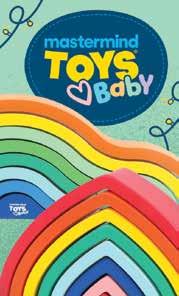


Birthday Perks programs, its community impact initiatives and its Holiday Play Guide, and it’ll also be featured in Today’s Parent ’s Gift Guide. “Beyond this year, we’ll strategically double private brand offerings, especially in categories where we believe we have the right to win, such as baby and outdoor,” she says.
Looking to the future, Mastermind Toys has plans to grow its sub-brand, Mastermind Toys Baby, launched in 2021. Designed with its littlest customers in mind, the brand will continue introducing itself to new parents as the official play partner of The Baby Show, and by offering its Perks loyalty members exclusive deals.
“I deeply believe in the importance of knowing and living your brand purpose with everything you do,” says Jordan. “Whether we’re making decisions on strategic opportunities, managing through a crisis or introducing a new category to our collection, I’ve reminded myself of what this beloved brand has stood for over the last 38 years.”
16 strategyonline.ca
BOY 22
WHEN KIDS PLAY WE ALL WIN.
Congratulations to the team at Mastermind Toys for being named a 2022 Brand of the Year. Love, your team at The Local Collective.

A re-education courtesy of the Canadian Down Syndrome Society
BY CHELSEA CLARKE
HHow do you peel back layers of misconceptions about a marginalized community? For The Canadian Down Syndrome Society (CDSS), it’s about re-educating a population and dismantling falsehoods, one by one.
In the last few years, marketing for the Calgary-based non-profit advocacy group has been driven by research, determining the societal biases that exist in the minds of Canadians so they can be addressed head-on. “Our best research comes from talking to Canadians with Down syndrome and their families,” says Laura Lachance, executive director at CDSS. “They tell us that they continue to encounter many obstacles to inclusion in society.”
Those barriers are based on outdated thinking about individuals with Down syndrome: that they’re incapable of holding jobs or can only work in the service industry, that they’re unable to live in their own homes or participate in romantic relationships, or unwelcome in the LGBTQIA community.
In addition to polling those with Down syndrome and their


families, CDSS also conducts formal large-scale studies to capture perceptions in the general population. It helps shape CDSS’s internal campaigns and those created in partnership with its agency, FCB. CDSS also enlists PR agency Glossy to help boost awareness and reach. “Our projects and campaigns are purposeful and bold. We align ourselves with agencies and groups that mirror those characteristics,” says Lachance of their partners.
Based on its research, from 2016 to 2019, CDSS’s campaigns focused on answering Google’s most-asked questions from parents who were expecting a child with Down syndrome (“Down Syndrome Answers”), educating people on how to congratulate a couple who’s expecting a child with Down syndrome (“Anything but Sorry”), the realities of underfunded support programs, high unemployment rates, housing issues and stigmas faced by those with Down syndrome (“Endangered Syndrome”), and working with Google to make voice technology more accessible (“Project Understood”).
CDSS’s education-based campaigns have gotten the marketing

18 strategyonline.ca
Through its research and community, the non-profit uncovers stereotypes and shuts them down, one by one.
Above Left: In CDSS’s “Anything but Sorry” campaign, the organization educates people on how to congratulate a couple who’s expecting a child with Down syndrome.
Above Right: CDSS continues to change perspectives. “MindSets” finds positive benefits of physical exercise on cognitive therapies, while “Love Means...” depicts people with Down syndrome engaged in a variety of meaningful relationships.

world talking, with top prizes awarded at AToMiC, One Show, Cannes Lions, Clios and others.
In 2021, CDSS released “MindSets,” a pivotal campaign driven by research that may change lives. The non-profit partnered with Anglia Ruskin University and BrainHQ to launch a global research study that collected data examining the effects of physical exercise on individuals with Down syndrome. (Historically, the area has been a sticking point, with general wisdom saying it wasn’t recommended for the community.) With 200 eligible participants recruited, it’s the first-ever statistically significant research to be conducted on this subject. While the data is still being processed, the study will eventually help shape advances in the connection between fitness and cognitive therapies for people with Down syndrome. The resulting campaign garnered 180M media impressions and 1.6M video views across social media channels.
Though societal winds are generally shifting to that of more inclusivity, Lachance notes that those with intellectual disabilities are still at the bottom of the list. “Across Canada, many children with Down syndrome are included and considered able in their own way during school years,” she says. “But upon graduation, they become ‘disabled’ again, labelled collectively as not having the ability to fully participate in society.”
CDSS’s 2022 campaign, “Love Means…” aims to change that. It tackles the adult issue of relationships in those with Down syndrome. In the photo series, curated by photographer Hilary Gauld, depictions of love are brought to the forefront. “Love within the Down syndrome

community is seldom shown. So, to change perceptions, we launched the intimate and informative series that shows the many ways love exists for people with Down syndrome,” says Lachance.

The campaign highlights a variety of relationships from romantic, to platonic and same-sex. “Right now, there is an overwhelming lack of awareness and understanding about the complete lives that people with Down syndrome live, and about the range of emotions they experience. This work was created to change the public narrative,” she says. “Love Means…” has been reaching the public by way of social media and PR outreach, methods of which have earned the campaign over 81,000 social media engagements as of September 2022.
But stigma and misconceptions aren’t the only factors CDSS has been tackling. The pandemic and uncertain economic conditions have resulted in a decrease in donations, as is the case across the entire non-profit sector, according to Lachance. “Individuals with Down syndrome have been disproportionately affected by the pandemic, particularly by social isolation and a disruption of regular routines,” she says. “It has been challenging for many.”
Lachance plans to change those economics through fund development. “We need to focus our work to support the strengths of those with Down syndrome and their caregivers,” she says. CDSS relies on social media, email marketing, and paid and sponsored ads to support fundraising efforts – and to share stories about the impact of donor generosity. “This year, we’re placing a stronger emphasis on our monthly giving program, The Connection, which will lead to greater sustainability for CDSS and support important future projects that directly impact the community,” she says.
As CDSS’s education-based campaigns pick up speed and the organization leads the charge in changing public perception, the next hurdle is bringing about change at the federal level. “Many individuals with Down syndrome require some support to live their best lives. Governments must provide an equal distribution of available supports to all who need them,” says Lachance.
When it comes to how much the CDSS has managed to change perceptions, Lachance notes that it’s not easily quantifiable. “Canada has been called a leader, but it is also impacted by larger global movements towards inclusion, acceptance, education and awareness, as other groups promote their own campaigns internationally,” she says.
So, the CDSS will keep finding misconceptions to knock down. Lachance says the organization is planning to tackle employment next. “We want to present the business case for employing those with Down syndrome by demonstrating how they can bring the right skill set to various roles,” she says.
While CDSS has used education as a vehicle to drive change, what matters most are the voices behind it – ensuring they’re heard, acknowledged and respected. Ever an advocate for CDSS’s work, Lachance knows the organization is invaluable to those who need it, offering them a platform to stand on and speak out loud: “We know that, as more people with Down syndrome are raising their own voices and expressing their hopes of living a full life in our society, our campaigns will highlight those aspirations.”
19Fall 2022
BOY 22
Zabiha Halal finds success through authenticity
one halal brand” is proudly amplified on packages. Zabiha Halal boasts a hefty 70% market share of the processed meat category, easily besting closest competitors Mina Halal and private label grocery rival, Sufra.
BY CHRISTOPHER LOMBARDO
IIt’s evolved from being a food brand into an advocate for the community. Focusing on real people and the authentic experiences of Muslims in Canada is what has set Zabiha Halal apart – and set the brand up for incredible success.
Part of what helped grow the Zabiha Halal brand was the simplicity of its “giving thanks” and “gratitude” messaging, says Sarah Khetty, marketing director at parent company Maple Lodge Farms. She tells strategy that initial brand growth came down to keeping it simple, too: telling Muslim arrivals to Canada that all they needed to do to find familiar food was to look for the distinctive green box in grocery aisles. That was enough to get the brand – which launched in 2004 and had an eight-year head start on its closest rival Maple Leaf Foods’ Mina Halal – through the door and resonating in the category.
It’s now become so dominant that the banner “Canada’s number-
As Khetty tells strategy, Zabiha Halal’s success is about staying true to its roots – providing halal-certified, tasty products for budget-conscious shoppers – but not stopping there. Equally important is thoughtfully innovating on the product side to attract an increasingly diverse and growing Muslim consumer base.
Resting on the fact that its customers are likely making more traditional meals, such as biryani, at home (and frankly, better, notes Khetty), the brand has leaned into producing more conventionally western options, such as striploin steak, burgers and chicken strips.

For the Zabiha Halal brand, it’s a balancing act. It has to accommodate the needs of more well-heeled second and third generation Muslim-Canadian consumers looking for “fancier” items and product innovation (shoppers who might be more comfortable with the omnichannel experience), and newcomers who are more likely to be focused on their bottom line in a high inflation environment (consumers who are likely more tactile in their traditional, physical shopping habits).
“The community is looking to us to innovate, grow and evolve
20 strategyonline.ca
The Maple Lodge Farm brand dominates the field by tapping into the desires of an ever-evolving Muslim-Canadian consumer.
with them,” explains Khetty, herself a second-generation MuslimCanadian. So, to break through to a routine-based halal consumer, the brand must convey that it has other products – ones that, in some cases, the Muslim-Canadian public has itself demanded –available on the shelf. For example, innovation in the frozen and non-frozen snack category was at the core of its recent August to October back-to-school campaign, one that highlighted pizza bursts, corn dogs and Chicken Stix. (The latter being the first of its kind to be available on a national basis.)
Such kid-friendly SKUs, Khetty explains, represent popular local staples that Muslim buyers would previously not have been able to consider. And they are also solutions for increasingly busy Muslim households – dinner quick-fixes that can be pulled out of the fridge or freezer as needed.
For example, Zabiha’s internal insights revealed that pizza kept coming up as a product offering consumers were keen to see from the brand. The team realized that by launching a frozen pizza burst (a halal pepperoni pizza twist on a classic childhood snack) it could stand in competitive set which is largely haram (religiously forbidden) because so many of the offerings include restricted food items.
To launch its new frozen microwave corn dogs and pizza burst frozen snacks, the brand and agency partners created a multifaceted campaign – a mix of OOH, digital assets, social assets and influencers – to ensure learning about these products was as easy as preparing them. To further drive trial, it drew eyeballs through digital flyer Flipp, too.
But while there has been impressive growth in the offering when it comes to quick-fix dinner options, that’s not to say the brand isn’t continuing to invest in the fresh food side of its business as well. This past summer, like other meat brands, Zabiha Halal tapped the cultural propensity for backyard grilling to be top of mind with BBQ fans with offerings like Classic & Spicy Italian Sausages.
In 2021, Zabiha found success as the only Canadian brand to bring mainstream sausage flavours – classic and spicy – to the Muslim community. It reached its demographic via geographic targeting and lifestyle and word selection, with a heavy focus on digital to be more efficient and engaging with a growing target, as Muslims now represent almost four percent of the Canadian population.
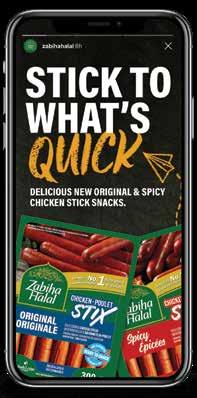
The brand’s award-winning “It’s All Halal” campaign, created by Toronto-based lead digital and social agency King Ursa, incentivized its target audience to engage in a trial offer that was available for redemption on the brand’s website, ultimately reaching 60% of the Muslim population across Canada with six million impressions and a 201% return on ad spend.
And its storytelling has changed alongside its increasingly digital presence. Since King Ursa came aboard a few years ago to work in tandem with Maple Lodge’s long-standing lead creative shop Riddoch Communications, media agency Media Dimensions and Craft Public Relations, Khetty says Zabiha Halal has evolved its messaging.
The brand went from relaying information about halal stores, explaining where to find products and securing more space in retail, to branching out through advocacy and addressing topics that can sometimes be difficult to broach – such as bigotry, discrimination
Opposite: Zabiha Halal brings Muslim-Canadian families together with conventionally western food items such as pizza and burgers.
Above: The brand’s award-winning “It’s All Halal” campaign incentivized its target audience to activate a trial offer. It reached 60% of Canada’s Muslim population, with a 201% return on ad spend.
and anti-Islamic sentiment. It’s through addressing these and highlighting the positive contributions by members of the Muslim community that the brand has really taken root.
You can see that evolution in the brand’s longstanding “Sharing Halal” campaign. Now going into its fifth iteration, it has been key to further driving an emotional connection to the company.
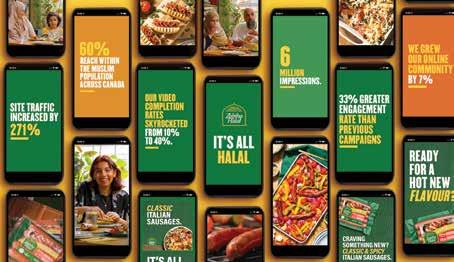
Four years ago, the first campaign was a Muslim and non-Muslim talking about sharing Ramadan and iftar – the evening meal that is a coda to fasting. But it has since evolved to not only address what brings Muslim-Canadians joy, but also what causes them pain.
According to a Leger study commissioned by the brand this past spring, while 81% of about 1,500 respondents reported that Canada is accepting of people with diverse backgrounds, 33% expressed concern about the number of Muslim immigrants entering Canada. This past summer’s campaign video, “Dear Canada,” was an open missive from Muslim-Canadians to create a deeper understanding of their personal experiences.
Says Khetty, “It’s about recognizing that if we are the largest brand that’s part of people’s lives and connecting to the Muslim side of their identity, we have a responsibility to speak up.”
21Fall 2022
BOY 22













BRP sells experiences, not products
customers is through research. “On a quarterly basis,” she explains, “we survey up to 1,700 customers who are new to the category. We’ve been doing this in nine countries since 2020, and we’ve learned that our customers are more diversified, younger and skew towards female. It’s a whole new customer profile entering the category.” Encouragingly, she notes, the most recent surveys show stability in new entrants, with many expressing an intent to remain.
BY WILL NOVOSEDLIK
Above: To entice young adventurers into Ski-dooing, BRP created Escape Mountain, a realitystyle show that aired on Discovery.
In 2016, powersports maker Bombardier Recreational Products (BRP) had annual revenues of under $4 billion and a share price of $26. Five years later, that had grown to $7 billion, with a share price of $90.
So, what kind of alchemy turned these growling off-road machines into gold?
When CMO Anne-Marie LaBerge joined the company in 2016, BRP president and CEO José Boisjoli was in the early stages of transforming the organization from a wholesaler to a retailer. His strategy? Don’t just sell machines – become an experience company and a leader in the outdoor community.
The company’s wholesaler mindset was a legacy of its B2B origins in aviation and transportation. But when it sold off its aviation division in 2018 and its transportation division in 2020 in order to focus on powersports, it was time for BRP to connect directly with consumers.
That was just fine with LaBerge, who had spent the previous 19 years in marketing roles at Telus. She was up for the challenge, given that her former employer had gone through a similar transformation during her tenure, evolving from a focus on engineering and product to one all about customer experience
One of the primary ways BRP is managing to connect more directly with its
So what’s driving the growth? LaBerge cites both a desire to reconnect with nature and the continuing explosion of the “experience economy”– think travel, food and adventure sports.
In 2017, just one month after joining, LaBerge created BRPX, an incubator to tap into the experience economy. Its first initiative was a program called Uncharted Society, a global network of outfitters that offer transformative powersport experiences.

Says LaBerge, “It had its first full year of business in North America and then launched in Europe this past year. I call it the Club Med of experiences. You can go to the Grand Canyon on a side-by-side [a four-wheel off-road vehicle] for four days, spend three days in Yosemite Park on three-wheeled Can-Ams, or try skiing or Ski-Dooing in Utah. And you can do all that without needing to purchase a product or trailer, or build a garage.”
The initiative has been so successful that BRP is now testing different iterations. In one, called OutCo, the brand has partnered with Fairmont Hotels and Resorts so consumers can book a stay and an experience in one go – and BRP provides all the gear.
“We ensure that they have a certain standard of care and service,” she says. “And, when you get there, you are fully taken care of. We dress you, we feed you, we provide you with a product that is no more than a year old. We’re planning to do this with snowmobiling in Finland and with side-by-sides in Dubai. We even have an office in Australia where we’re testing a side-by-side experience in the Red Desert.”
Another BRPX experiment is something called Playground, which sees the brand partner with private landowners who have access to properties with especially unique features and rare natural beauty. Clients pay a membership fee to access these incredible playgrounds, which BRP curates and provides access to via an app.
23Fall 2022
How a maker of machines has become a storytelling powerhouse.
I BOY 22
Above: “Uncharted Society” offers clients a global network of powersport adventures. (Think: the Grand Canyon on a side-by-side, or Ski-Dooing in Utah.)
For BRP, it’s not about selling machines.

It’s about real people having real experiences.
But it’s not all about servicing existing clients better. The team is also eager to jump on new opportunities when they suggest themselves in the data.
For example, when the quarterly surveys revealed a heightened interest from female riders, the brand took notice. BRP had already put together a task force charged with increasing market share in three-wheeled products – and the company knew that only 20% of motorcycle riders were women, and that women tend to

market fit, there is also customer involvement in product design.
“We say that we design our products from the rider down,” says LaBerge. “For example, we noticed a group of fishermen in New Zealand who used Sea-Doos. We went fishing with them in Auckland and we could see that they were making all kinds of adjustments to be able to use our product. So we took that learning and created a version based on their needs.
“As I keep on telling my engineers, not everything is about product. It’s about how customers use the product, what we can learn from them and how to design to those needs at every touchpoint.”
All this first-person learning helps feed the BRP content machine, too. “To win the hearts and minds of customers, we need to become great storytellers,”
test and learn before committing to a machine purchase. So it set up a rider education program for its three-wheeled Can-Am, the Ryker, and started a group called Women of On-Road. The community now has 16,000 members. Women can go online and share their concerns and questions in a safe environment, asking about things that they may be less comfortable asking more experienced riders.
The result is that 36% of Can-Am Rykers are now owned by women, a stat unheard of in the motorcycle industry. Says LaBerge, “It’s almost like a brushfire effect now. There are women talking to women, who are talking to other women. We’re seeing exactly the same movement in Europe.”


To achieve and maintain the best product-

asserts LaBerge. “So we created our own in-house media agency. It has become a platform for real riders to share their stories with the rest of the community, and anyone else who is interested.”
One content series, “Where the Pavement Ends,” is about off-road riding. Another is about a Brazilian wildlife photographer using a Sea-Doo on the Amazon River in search of a very rare jaguar. “It’s real people, real context, real stories,” notes LaBerge. “And we have 200 brand ambassadors doing this kind of content.”
As a result of the success of these programs, BRP is moving away from a campaign-based to a content-based model. Now that the brand sells products in 117 markets, it’s as much a practical decision as it is a brand decision.
“I would never have enough marketing dollars to be able to do traditional marketing in all those markets,” she sums. “So we co-create content from Brazil, Europe, Asia-Pacific, North America and share it. My ultimate goal is that people who’ve never purchased – and may never purchase – any one of our products or services would want to sit and watch our content. We will have succeeded when we can go beyond the riders and really touch the hearts of people who might never be our customers.”
24 strategyonline.ca
BOY 22

Get corner office perspective in your inbox. Sign up for your free weekly briefing on how Canada’s brand leaders are responding to market challenges and acting on new opportunities. strategyonline.ca/subscribe MARKETING C-SUITE
CURATING A PURPOSEFUL LIFE
the ideas were first percolating, a seasoned retailer might not have put books and groceries in the same sentence, let alone the same store.
BY WILL NOVOSEDLIK
Duke Ellington. The name conjures up adjectives like urbane, sophisticated and elegant. Listening to his music is like curling up with a good book. It soothes the soul.
Heather Reisman, founder and executive chair of Indigo, wanted to create those same feelings some 25 years ago when she first started turning over the concept for a new kind of bookstore in her mind. “From the beginning, what we wanted to do for customers was inspire, inform and indulge,” she explains. “And it was those three words, while I was listening to Duke Ellington’s Mood Indigo, that inspired the name.”
For as long as she can remember, Reisman has loved books. “Bookstores are my happy place,” she explains. “I would buy everything – including my groceries – in a bookstore if I could.”
But that wasn’t really done at the time. In 1996, when
But Reisman was not a retailer when she opened the first store in 1997.
Instead, she looked around the retail landscape and saw an opportunity for something new.
“I’m not sure a business school analysis would have confirmed there was an opportunity for me, particularly as I had never been in retail,” she reflects. “But I was a customer and, as good as the existing players were, I had my own vision of what I would want in a great bookstore. That vision propelled me to take the risk.”
Reisman knew the market was ready for a more curated experience – one that had all the intimacy, love and service of a small independent, coupled with the dynamism and opportunity offered by operating at scale. It would have space for other cultural products –music, movies, beautiful writing papers. It would be a candy store for the mind.

What she ultimately landed on was the idea of “a cultural department store” – and there was nothing quite like it in the marketplace at the time.

26 strategyonline.ca
OVER
THE COURSE OF 25 YEARS, INDIGO BOOKS & MUSIC HAS TRANSFORMED ITSELF INTO A COMPREHENSIVE LIFESTYLE BRAND THAT CUSTOMERS HAVE COME TO LOVE.
Left: Indigo gets some of its best ideas from a 10,000-strong customer panel dubbed the “Indigo Innovators.” The intel has helped in the development of proprietary products like OUI, Nóta, The Littlest, Mini Maison and IndigoScents, as well as Love and Lore.
Right: Indigo was designed from the start to be a “cultural meeting place” that’s all pleasure and no guilt.
1997 Indigo opens its first store – Indigo Books Music & More – in Burlington, Ontario.

2000 Indigo expands to 14 locations across Canada and launches indigo.ca.

2001 Chapters and Indigo merge to form the largest book retailer in Canada under the name Indigo Books & Music Inc.
2003 Indigo makes music available online, ready to ship within 24 hours.
2004 Indigo establishes the Love of Reading Fund (now the Indigo Love of Reading Foundation), a charitable initiative dedicated to enhancing literacy and self-esteem in students. Indigo also starts the Junior Advisory Board, a team of Canada’s best and brightest young readers, to provide their opinions on what youth want to read.
2006 Indigo opens an awardwinning store in Brossard, Québec. This new concept store is the largest bilingual bookstore in the Montréal area and features thematic boutiques to allow book lovers to easily identify each section. Indigo expands its product line-up to include toys and opens in-store toy departments at Yorkdale and Bayview Village locations in Toronto.
2008 The launch of the Indigo Online Community, which gathered together more than 275,000 book lovers in the first year, wins gold at the Canadian Marketing Awards for Social Media.
2009 Indigo spins off its digital eReading division to form Kobo Inc., a global eReading company now operating in over 100 countries.
A DIFFERENT KIND OF DEPARTMENT STORE
One person who wholeheartedly agreed with the vision was designer Bruce Mau, who became involved in the Indigo launch and brought in architects Kuwabara, Payne, McKenna and Blumberg to help shape the vision. One of the signature features of the retail space was its declaration of pride in Canadian culture. “The world needs more Canada” featured prominently on a massive mural in the flagship store, along with the names of Canada’s most celebrated artists, writers, musicians, actors and filmmakers. Says Mau, “It was one of my favourite things. It’s such an audacious, un-Canadian thing to do, which is why the tagline is so brilliant.”
Mau describes the original concept as a cultural meeting place. As he tells it, when the first store opened in Burlington, Ontario, “Moms wandered through the store in tears. They had never seen such a place.’” It became a kind of cultural oasis.
Indigo president Andrea Limbardi, now a 20-year veteran of the brand, concurs. “Our customers call Indigo their ‘happy place,’ a place that’s all pleasure and no guilt. I’m driven to create an environment where our customers can get away from the stresses of their everyday lives whenever, however and every time that they interact with us. We’re striving to be a reprieve from all of that noise.”
EVOLVING FROM BOOKS TO LIFE
Visit a store today and it’s pretty clear that it’s about more than books. When asked what made her decide to expand into other categories, Reisman says, “We built a wonderful connection with our customers in
the book business. Then, organically, certain products became less relevant and others were opportunities. Our starting point was always books, big ideas, culture – and culture is about food, travel, creativity, as well as the big, important threads which occupy our thoughts.”
Adds CEO Peter Ruis, “There was this idea of taking all of the purpose and the intentionality that you get from books and bring in products around them that are curated and interesting and have been bought without an algorithm, with real people in mind.”
Ruis has now been with Indigo for two years. He comes to the brand with extensive experience in retail categories such as fashion, home, beauty, food and beverage. He explains Indigo’s growth into other categories as the natural evolution of a brand whose average in-store dwell time is well above most other stores (where it tends to hover around the 45-minute mark). It just makes sense to pair a collection of cookbooks with a collection of cookware, he suggests.
To help spur those ideas, Indigo relies on the combined power of an internal design team and a
27Fall 2022
THE INDIGO STORYLINE >
2010 Six superstores open across the country and Indigo expands its IndigoKids departments in 30 locations.
Kobo launches its first eReader in the spring and releases a Wi-Fi enabled eReader in the fall.
2011 Indigo starts its free, points-based plum rewards loyalty program. Within six months, membership approaches 2M. Indigo transforms 25 of its
superstores with new fixtures and increases square footage to showcase its home and fashion accessory categories.
By January, Kobo sells two million readers in over 100 countries. Over the course of the year, that grows to seven million. Indigo successfully introduces its third generation eReader, the Kobo Touch, in June.
2012 Indigo concludes the sale of Kobo to Rakuten for US $315M. The plum rewards loyalty program reaches 5.8 million members.
2013 A redesign of the chapters.indigo.ca online store includes a focus on new areas of growth, from paper and toys to gift products such as home and fashion accessories. A total of 37 Indigo Tech shops also launch.

2014 Indigo launches three American Girl shops within IndigoKids in Vancouver, Toronto and Ottawa stores.
2015 Indigo is named Top Canadian Retailer in the Randstad Awards for most attractive retail employer, the most attractive employer for women and people aged 18 to 24, and the employer with the most attractive work environment nationwide.
2016 Indigo opens the world’s first cultural department store at Sherway Gardens. The 30,000-square-foot location contains more than 90,000 unique book titles, an expansive IndigoKids section with built-in American Girl boutique and other shops-within-a-shop.
2017 Indigo is named Top Retail Employer Brand in the Randstad Award for the second year, and
10,000-strong customer panel to evaluate and come up with product ideas. The customer panel, dubbed the “Indigo Innovators,” is consulted regularly, while the design team develops proprietary products like OUI, Nóta, The Littlest, Mini Maison, IndigoScents as well as Love and Lore to help power those pairings.
Modern homeware brand OUI, for example, launched in 2020 with categories like sleep and bedding, storage and organization, sustainable living and functional kitchen. Nóta, meanwhile, launched in 2021 and is a collection of
stationery, gift wrap and home office products made with sustainability as a key pillar. The assortment is rounded out by responsibly designed products ranging across stationary, journals, calendars and gift wrap.
Together, these two internal brands generated over 25% of total revenue growth last year, which amounts to roughly $40 million. The brand hopes to repeat that success in categories such as gifting, tech, plants, gourmet, arts and crafts, vinyl records, Manga, wellness, kids and baby. All in good time.
>
ranks as one of Canada’s Top 10 Most Trusted Brands in the Gustavson Brand Trust Index.
In celebration of Canada’s 150th birthday, Indigo releases its first-ever coffee table book, The World Needs More Canada –Indigo’s definitive celebration of what it means to be Canadian.
The Indigo Love of Reading Foundation launches Read Between the Lines, a 35-minute documentary that shines light
on the chronic underfunding of high-needs elementary schools in Canada (loveofreading.org).
2018 Indigo opens its first U.S. location at The Mall at Short Hills in Short Hills, New Jersey.
2019 Indigo launches the new IndigoBaby Registry and the IndigoBaby shop at Sherway Gardens in Toronto.
Indigo launches thoughtfull.co, a
site that provides a gifting solution with digitally fulfilled delivery.
2020 In the wake of the pandemic, the Indigo Love of Reading Foundation commits one million dollars to provide books to families in need through its Community Response Fund.
Indigo launches OUI, which delivers living solutions that make room for life.
In October, the company
becomes the first major Canadian retailer to sign the “15 Percent Pledge,” committing to increase its representation of Black and Indigenous authors, as well as BIPOC-owned third-party brands for its lifestyle business, to a benchmark of 15%.
2021 Indigo announces its commitment to have net-zero emissions by 2035.
In February, the company signs
the BlackNorth Initiative Pledge to take action to end systemic anti-Black racism.
IndigoKids and IndigoBaby launch local business program Mini Marché, highlighting and supporting small, local Canadian businesses. Indigo introduces its proprietary brand Nóta, a new collection of notebooks and journals, made from FSCcertified paper and recycled materials.
Right: Indigo was the first Canadian retailer to join the #15PercentPledge –an initiative launched by designer Aurora James which asks sellers to dedicate at least 15% of their shelf space to BIPOC businesses.

CURATING A PURPOSEFUL LIFE
“I think a lot of brands tend to do one of two things,” says Ruis. “They stick with what worked in the past and just go on and on with the same platform forever, maybe with minor tweaks. Or they tear it all up and re-launch. Twenty years ago, you could have looked at the book business and pretended Amazon wasn’t happening, or eBooks weren’t a thing or that people were going to stick with DVDs rather than start streaming. Or, you could have expanded into new categories. Good brands adapt to the times.”
That’s true in retail more than most categories, and it has been true of Indigo more than most retail brands. After merging with Chapters in 2001 – itself the result of a pairing of two of Canada’s major bookstores, Coles and Smithbooks – Indigo Books & Music could boast 50% market share and had effectively become the largest bookseller in the country. The company has spent the ensuing 21 years evolving from a bookstore into a book-based lifestyle brand.
Whether that means hosting a Harry Styles record launch or bringing in a line of handcrafted Portuguese bed linens, Indigo has taken its brand to a more experiential level. “Our brand is based on the idea that you can bring your personal purpose to life via books and related merchandise,” says Ruis. “Whatever your purpose or passion, you can bring that journey to life via the store.”
To that end, in September, Indigo unveiled its new brand platform: “Life on Purpose.” Says Ruis, “The message to our teams is: everything we do, every product we make or curate, has to have a purpose, a reason to be there. That includes whether it’s ethically and sustainably made. We’re not taking merchandising
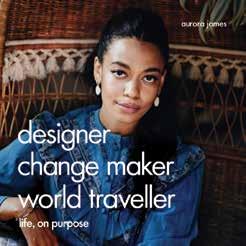
decisions lightly. We don’t just want to become a marketplace for the sake of selling more stuff.”
“It’s the idea of taking what customers call their ‘happy place’ and amplifying that experience in every way, from product development and curation to a new website, new store designs and an expanded assortment,” Limbardi adds.
REBOOTING A DIGITAL PIONEER
It also means being ready for whatever sudden changes the market throws at you. Indigo was an early adopter of e-commerce, launching one of the first online book stores in Canada – indigo.ca – in 1999. Over the years, the digital ecosystem has grown organically, but sometimes you get a chance at a total reboot. Indigo got that opportunity because of COVID-19. In early 2020, Limbardi and her team had set out to create a future state digital technology roadmap to fully modernize their 20-year-old technology stack. When the pandemic hit, they were already committed to bringing together a best-in-class martech and digital technology suite. With stores closed, the abrupt, pandemic-induced pivot to digital across the entire organization in the fourth quarter of fiscal 2020 included optimizing the website experience, customer service automation, an express pick-up offering and curb side pick-up, among other things. Additionally, third-party, same-day fulfillment solutions, including Instacart in 2020 and Cornershop by Uber in 2021, enabled customers to have their orders delivered in as little as an hour in markets across Canada.
29Fall 2022
Top: In 2010, Indigo expands its IndigoKids departments in 30 locations, furthering its goals to position Indigo as the ultimate familyfriendly destination and the largest specialty toy retailer in Canada.


PLANNING FOR THE NEXT 25 YEARS
If the brand is a canvas for the purposeful pursuit of one’s passions, it’s also equally one for informed retail experimentation.
One example is Indigo’s concept store in Short Hills, New Jersey, about an hour’s drive west of Manhattan. “That’s been a really fascinating story for us,” says Ruis. “We took our concept and shifted it a little bit, tilting it more towards general merchandise. We adjusted the ratio of books to merchandise from 55% books and 45% general merchandise – which is our
typical mix in Canada – to 40% books and 60% general merchandise.
“We found a niche. We became the preferred destination for New Yorkers for coffee table books. In fact, every decorator in New York comes to that store to buy these big format coffee table books for their clients’ homes. So we go from books about décor to books as décor. Who knew? That store has had an incredible year.”
Are there plans to expand further into other markets? Maybe, but there’s no rush.
“It’s not something that’s going to happen in the next two years because we have so much opportunity here in Canada,” answers Ruis. “We think we can double the business here. But it shows that this ‘life on purpose’ brand is not one dimensional. It’s not the old Chapters business where you walk in and just have loads of books. It has far more elasticity, more growth potential.”
Sums Heather Reisman, who says her proudest accomplishments have been building a strong team and achieving a high level of affection for the brand: “We’re far from done. There’s much more of the story to come.”
cheers to 25 page-turning years of Indigo from your friends at


strategyonline.ca/subscribe Stay connected with daily brand news. Sign up for your free daily briefing and get context for all the marcom news, research & trends impacting the Canadian market.
hey cossette, thanks for helping us to put peoplefirst.
Cossette has been our strategic and creative partner since 2018, helping nabs to provide assistance to those in need within the communications industry. Our friends at Cossette created outstanding work for us, including: the 2018 “Who is nabs” video; 2019’s ADCC stunt; our current Mr. Crumbles “This job can break you if you let it” campaign; and our nabs “people first” mantra. Not only did Cossette provide their impactful work pro bono, but they have also been a generous donor of both money and media. We’d also like to extend our thanks to the following companies and their incredible staff, who helped to make our messaging possible: Art Jail; Grayson Music; Jigsaw Casting; Outsider Editorial; Pirate; Skin & Bones; Soda; Tantrum Studio; The Assembly. They’ve all been there for nabs so that we can be here for you. with deepest gratitude, from your friends at
nabs is a registered charity, entirely funded through the generosity of our donors and media partners. To date, we have supported over 50,000 individuals and their families.
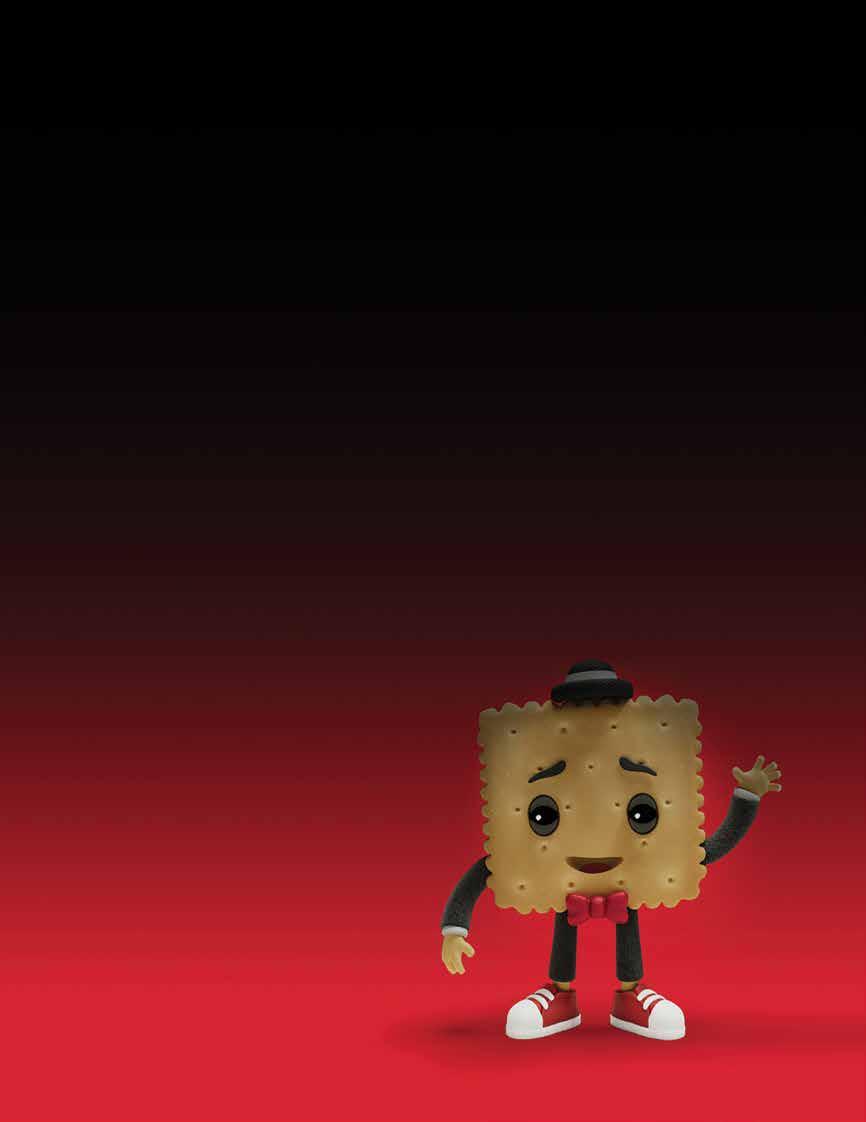
2022 OFAGENCYYEARTHE
“Growth and comfort do not coexist,” former IBM topper Ginni Rometty once asserted. And she was probably right. It can take times of great tumult to bring about great change, and the last couple of years have been… one might say… a little tumultuous.
But, as we emerged from the chaos this past year, in many ways things started to feel like they were changing for the better. The pandemic made the world very small – as small as you can get – and that’s being reflected in how the industry works. Whether that’s addressing the needs and concerns of consumers on an individual level, or finding new and better ways to source, secure and retain talent, the way forward became all about real people and how we can make their lives better. And that’s no small thing.
Throughout our Agency of the Year stories, we frequently heard words like “empathy” and “value-add,” and talk of
the need to be even more entrepreneurial. What we didn’t hear was a lot of pessimism or stagnation, even in the face of considerable uncertainty. (In fact, several of our subjects thought this was a good year to invade the U.S.)
The year may have been tumultuous, but there was no shortage of brave, creative, groundbreaking ideas – and we’ve got the evidence to prove it. What follows is the 2022 roundup of strategy’s annual Agency of the Year winners. Decided by jury members from brands and agencies (check them out starting on pg. 68), our overall winners in six categories represent a new crop of gold medalists – some familiar, some new to the top of the podium.
So, get yourself comfortable and settle in with a cup of something warm. It’s time once again to celebrate the resilience of a remarkable Canadian industry.
33Fall 2022
Rethink: One Agency. So Many Awards.
 BY JUSTIN CRANN
BY JUSTIN CRANN
DIGITAL
IF ACHIEVING SUCCESS is difficult, maintaining it must decidedly be more so. But try telling that to independent creative agency Rethink – which has, for the fourth consecutive year, claimed Strategy’s Agency of the Year and Design Golds, while snagging a fourth straight medal finish in Digital and adding another in a category new to the agency: PR.
For Rethink, it’s all the by-product of an intentional strategy to drive creatives to do the best work of their careers – even through the pandemic, and notwithstanding borders and other boundaries. And it all stems from one simple fact: “Rethink is never going to sell.”
Those are the words of Sean McDonald, national managing partner and CSO at Rethink, who says it’s a fundamental difference-maker for one of the world’s largest and most-decorated independent agency networks. “The typical way an independent agency would think is: ‘How can we expand?’ because they want to grow so they can be worth more. Rethink is not motivated by growth. We’re not planning to expand, we’re planning to improve,” McDonald tells strategy
It’s an interesting sentiment from one of the managing partners of an agency that has opened its first international office in New York City and expanded its total headcount by more than 35% in the past year alone – growing from a team of 235 last fall to approximately 320 as of press time. But McDonald is insistent that this growth is driven by a desire for improvement, rather than a higher valuation.
“If we improve, we have better relationships, which means we do better work. If we have better relationships and do better work, we have better careers,” he explains. “If we can expand the scope within which we have great relationships and do great work, and that requires us to be present physically in other places, we will do that. But
34 strategyonline.ca
AGENCY | GOLD + DESIGN | GOLD + PR | SILVER +
| BRONZE
2022 OFAGENCYYEARTHE
the motivation is not growth, it’s improvement.”
That goal was at the heart of the New York City office opening. Rather than take a Field of Dreams approach, McDonald says, Rethink decided to plant roots in the media capital of the world because it was already a global agency. The agency had been doing international work with clients including IKEA, Molson Coors, Tazo and Kraft Heinz for years, as well as work in the U.S. for Kellogg on RXBar, an assignment won in the summer of 2021.
“We had the opportunities already in hand, and we’ve gained more since,” McDonald says, with specific clients to be named closer to when the first work with them is live and in market. “It was validated through the business lens, but we opened the office in pursuit of finding great
people and work, in as many places as we can.”
And yes, that does mean that Rethink has its sights set on markets further afield. “Many Rethinkers and many of our clients are doing the best work of their careers in Canada. We wanted to do that with more people around the world,” McDonald notes. “That means in New York, and it also means well beyond Canada and the U.S.”
Speaking of “best work,” Rethink has secured its usual lion’s share of recognition this year – including 12 Cannes Lions (the most of any Canadian agency), 16 Clios, 10 One Show Pencils, five D&AD Pencils, and recognition as the top independent agency in the world at the Clios, top Creative Strategy Agency of the Year and third Independent Agency Network of the Year
| AGENCY
1. Well, hot dog! Rethink’s campaign for Heinz, “Hot Dog Pact,” was an overnight success. Setting out to disrupt “big bun,” the campaign saw $13MM in earned media and 1.2 billion earned impressions, and even persuaded Wonder Bread to begin selling buns in 10-packs. Heinz’s most successful earned media campaign in its history, the brand saw a 2.3% increase in overall sales from 2019 and a 1% increase in market share.

2. For Decathlon, Rethink created signs of inclusivity. “Ability Signs” were made available for free download and gained international coverage, with many outlets requesting to use the symbols in their locations.

3. “Hockey for All” told true stories of discrimination in the sport. The campaign resulted in $2M in funding for underrepresented groups.

4. A&W needed to explain the value of better food to consumers, so “Grass-Fed Beef Chefs” focused on the brand’s commitment to quality. The effort helped increase market share by 0.4%.

5. Rethink created an unburnable book to protest censorship and book banning in schools. Social followers were enthralled when Margaret Atwood took a flamethrower to her own novel.

AOY Campaign of the Year
For full
go to agencyoftheyear.strategyonline.ca/winners
35Fall 2022
cases,
54 2 1 3 CASES
1. Breaking bread.
It had been a long time since Canadians were able to properly celebrate over dinner. So long, in fact, IKEA realized our entertaining skills might have gotten a little rusty. Enter IKEA “Set-the-Tablecloths,” for people who needed a little help. The campaign delivered 6x the benchmark click-through rate, and 64% of site visits were new, showcasing IKEA’s holiday products to a whole new audience.


2. For more than 45 years, the National Magazine Awards have been considered the most prestigious in Canada’s publication community. Rethink was tasked with creating an identity for the 2021 installment. 3. Although Purdys had grown in sales over the last five years, it wanted to be sure it was serving all customers. The “Holiday Braille Box” was a fully accessible box of chocolates made in consultation with the blind and partially sighted community. An initial run sold out in hours and, as a result of the demand, the box has been made available yearround. The campaign had an earned media value of 395x the initial investment, with national and international outlets picking up the story.
at Cannes. It has achieved that recognition as a result of work done for a variety of clients, nationally and globally, including Kraft Heinz, Scotiabank, McCain Foods, IKEA, the YWCA and more.

To service those and other clients, the agency has added a number of new talents. In Toronto, these include Michelle Spivak as CD and Allan Mah as ACD, along with Amira Moussa, Amber Arezes and Jaclyn McConnell as art directors and Marwa Hassan, Aman Soin and Sean Weidman as copywriters. Rethink has also promoted a trio of group strategy directors to lead the practice in Toronto: Julian Morgan, Crystal Sales and Nicole Rajesky.
In Vancouver, the agency has seen tremendous growth, expanding its mandates with WestJet and A&W and adding new work with Destination Canada and McCain. McDonald previously told strategy that the agency’s Vancouver strategy team, alone, had nearly doubled in size over the past year. To help the agency manage its growing workload
in that market, Rethink hired Karen Pearce as general manager of the office, while Elyse Sanders was hired to take on the duties of head of strategy. Of course, thanks to its “long hallway” philosophy, growth in one market means growth across all markets for Rethink, which operates with a borderless approach, where employees of any office are encouraged and expected to contribute to work being handled in others. Approximately 45 Rethinkers are currently working on U.S.-based clients, for example – including Rajesky.
“We were born in Vancouver, have grown across the country and now into New York,” explains McDonald. “We’ve done that by replicating our model and staying as one Rethink, no matter where we go. COVID showed everyone something Rethink already knew: We are one agency, one culture, in many different places… The pandemic didn’t change us. It forced us to double down on what got us here.”
36 strategyonline.ca
2 3
1
For full cases, go to agencyoftheyear.strategyonline.ca/winners 2022 OFAGENCYYEARTHE CASES | DESIGN AGENCY | GOLD + DESIGN | GOLD + PR | SILVER + DIGITAL | BRONZE 2
KEY NEW BUSINESS
Tazo Nestle (Perrier, Pellegrino, Haggen-Dazs, Aero), Wonder Bread, Away Luggage, Scene, RX Bar, McCain, Destination Canada, Happy Planet, BC Women's Health Foundation, Hudson's Bay Company, Lactalis Canada (iÖGO, Lactantia), Special Olympics Canada
OFFICES
Toronto, Montreal, Vancouver and New York City
CASES | PR CASES | DIGITAL

1. Soar like a... Chicken?
For Simulate, a plant-based meat company, Rethink needed to convince the world that the brand’s marquee chicken nugget product, Nuggs, was just as good as the real thing. So, it came up with Flying Chickens, a campaign powered by fake videos of the mostly flightless birds... er, flying. The campaign captured more than 2.5M impressions in traditional media, 18.6M impressions in paid media and 7M impressions in organic social reach.

1. Spotlighting inequality.
“Add the M” – an effort to point out the disparity between the support for women’s and men’s sports – achieved a total reach of more than 99 million earned impressions. With a production budget of just $2,000, Rethink started a conversation with no paid media, achieving an earned media value of over $922,000. It was YWCA Vancouver’s farthest reaching campaign ever.
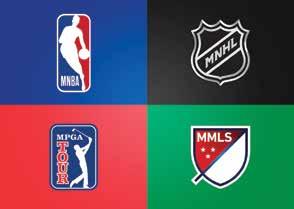
2. IKEA looked beyond the rainbow Pride flag to create 10 custom love seats inspired by 10 different Pride flags. Love Seats was shared online millions of times with an organic reach of over 244 million. It was called “The Most Authentic Pride Campaign of 2021.”

3. Post-COVID, GO Transit and UP Express had the mammoth task of correcting a 92% dip in ridership. The people to help them do that were Rethink and Francis Bourgeois, TikTok’s pre-eminent trainspotter. The resulting videos garnered a total of 14.6M impressions. Weekend ridership improved from just 50-60% of prepandemic ridership to an average of 94% in the month following the video launches. Furthermore, ridership exceeded 2019 numbers for the first time since the start of the pandemic.

For
go
agencyoftheyear.strategyonline.ca/winners
2. Tree Canada wanted to educate people about the impact of their online activity. So Rethink created “Offset Mode,” an effort powered by a free Chrome extension that calculated the emissions tied to your online activity. The app has now been downloaded globally by more than 1.5M, in locations like in Canada, the U.S., Bermuda, China, Norway, Ukraine, Australia, South Africa, Hong Kong and New Zealand.
3. They are the iconic food power couple: fries and ketchup. Rethink blended Heinz and McCain for “The Love Collab,” the celebration of a truly great relationship. The campaign earned more than 105M media impressions and spurred a 700% increase in brand engagement.
For full cases, go to agencyoftheyear.strategyonline.ca/winners

37Fall 2022
full cases,
to
1 2 3
STAFF 320
2 1 1 3
KEY NEW BUSINESS
Destination BC, Save-On-Foods, ToursByLocals, A2 Milk, DNA My Dog, Medline Canada, Ninepoint Partners, Pizza Pizza, UHN, Hydro One, Yorkville U
NEW HIRES
Christine McNab, Dean Lee, Michael Mayes, Kelsey Hughes, Ryan Kukec, Erin Rodness, Lucyed Hernandez, Shelagh Moore, Karishma Wadia, Tanios Nims, Samantha Lee, Dejan Djuric, Jackman Chiu, Crystal Huang, Ana-Marija Vlahovic, Jaya Rizzi, Corina Wilkes, Alexa Macdonald, Cindy Nguyen, Erika Dafore, Cosmo Haskard, Shauna McKenna, Robin Scott, Sasha Dan, Ela Profka, Vipandeep Singh, Abdulla Barakji, Amanda Wong, Amy Nguyen, Vipul Deshpande, Samantha Tang, Meredith Ferguson, Patrick Henderson, Cameron Fleming, Vittoria Gibson, Alicia Petralia, Anushka Prakash Babu
OFFICES

Toronto, Vancouver, New York
Zulu Alpha Kilo embraces the chaos (again)
BY WILL NOVOSEDLIK
FOR ZULU ALPHA KILO, THIS LAST YEAR has been one of investment and expansion – and maybe that’s not all that surprising. Zulu has made a habit of flying in the face of the expected.
This is, after all, the agency that first opened its doors in Toronto in 2008 during an economic crisis. So it made perfect sense for it to undergo a huge expansion during a pandemic that had the whole world in turmoil. The last year has seen Zulu expand both nationally and globally, with offshoots opening in Vancouver and New York. The latter represents the team’s first international growth, opening under the supervision of former Droga5 creative leader Tim Gordon, who was brought in to Zulu as CCO and partner.
And Gordon wasn’t the only top-level personnel move this past year. Another was the addition of former Rain president Christine McNab, who will serve as Zulu’s new
CMO, and has been given the mandate to continue to build the brand globally. She’ll also assist in growing and shaping the firm’s production offering, Zulubot, as well as AR, media innovation and CX operation, Zulumatic.
“We’ve doubled down on our investment in people,” sums Zulu chairman and chief creative officer Zak Mroueh of all the growth. “We’ve doubled down on our investment in the future.”
For good measure, the company also bought its own building during the pandemic to serve as Toronto HQ, hiring a top-tier consulting firm with expertise in the hybrid work model to inform the design. Although Zulu will continue giving its employees the flexibility to work from home, the hope is that the energy of a purpose-built studio full of creatives will slowly bring people back.
With all this high-level moving, shaking and expansion going on, it might almost go unnoticed that Zulu Alpha
38 strategyonline.ca
STAFF 140
AGENCY | SILVER 2022 OFAGENCYYEARTHE
Hit the road. Zulu and Pfaff Harley-Davidson joined together to give Sikh Canadians an opportunity to take to the open road by creating safety headwear that’s in line with their religious beliefs. The design for the “Tough Turban” – a helmet made from 3D-printed armour, Dyneema and non-Newtonian foam – is available open source to any manufacturer.
Kilo had yet another banner year in 2022. Epica named it Independent Agency of the Year. It was ranked as the number-one agency in the world at the New York AME awards, and overall Agency of the Year at the UK’s Drum Awards. It won Best of Show at the Media Innovation Awards (MIA), and Zulu was the only Canadian agency to win, as well as the most awarded shop, at the UK’s Indie Awards. It garnered 14 nominations and won six awards from the Canadian Marketing Association and was ranked in the top 10 independent agencies at the D&AD and One Show. The list goes on. On top of that, Deloitte named ZAK one of Canada’s Best Managed Companies for the fifth year running.
The recent work is well known. Consider “The Micropedia of Microaggressions,” an online tool designed to help people understand the most common forms of discrimination. For Home Equity Bank, in partnership with the Royal Canadian Legion, Zulu created Orders of Sacrifice, replicating historically accurate World War II field ration kits that could be ordered through DoorDash to support veterans and their families. For Subaru, Zulu executed a brand refresh under the tagline “Welcome to Uncommon,” which focuses less on individual car models and more on the people who drive them. New business wins this year included Save On Foods, A2 Milk, Pizza Pizza, financial management company Ninepoint Partners and Destination BC.

So, while many might have chosen to wait and see what the fallout of the pandemic might have been, that’s just not Zulu’s style. The agency’s combination of talent, independence and aspirations has brought it 14 years of successes. Given its latest moves, it’s in a strong position to continue that track record.
1. Old, but cagey.
By portraying seniors as savvy investors instead of hapless simpletons, “Retire in the Home You Love” helped HomeEquity Bank surpass $1 billion in reverse mortgage originations in 2021 for the first time in the company’s history.

2. “Setting the Tone” for Harry Rosen humorously focused on “golfcore” –fashion for the links. It more than doubled norms for favourability (125%).

3. To show how Subaru drivers are unlike others, “Welcome to Uncommon” showed how they’re up for any adventure, helping Subaru realize over 59M digital impressions.

4. Working with Door Dash to deliver World War II field ration kits, the Royal Canadian Legion generated media coverage across Canada with “Orders of Sacrifice.”

5. The “Micropedia of Microaggressions” noted all the ways we can be unkind without thinking, delivering 8M earned impressions and tons of press.
For full cases, go to agencyoftheyear.strategyonline.ca/winners

39Fall 2022
2 3 4 CASES
1 Design Campaign of the Year 5
OFAGENCY
BBDO thinks outside the brief
BY BRENNAN DOHERTY
AS THE WORLD CONTINUES TO OFFER NEW challenges, BBDO just keeps grinding away with its head down.
But the northern contingent of the eminent NYCbased advertising agency network isn’t just focused on landing awards at Cannes Lions or checking boxes to satisfy clients like Foodland, Sobeys and Rockstar Energy Drink. It’s about taking the next step and doing something more.

“We love that some of our best work could never have been on a brief in the first place,” says BBDO CEO Christopher Andrews. For him and the agency, it’s about going well beyond the brief.
He points to the Lego-style inclusive toys BBDO designed last year for the Canadian Paralympic Committee. The effort was part of the awarenessraising “We’re Here” campaign that put the emphasis on the athletes, with the goal of making them household names. (The work took gold in design at the aforementioned Cannes Lions.)
Another project he highlights is the recent “Missing Matoaka” for Indigenous arts and culture publication Muskrat Magazine . Setting out to tell “the true story of Pocahontas,” the campaign was created as a response to calls for justice coming out of the National Inquiry into Missing and Murdered Indigenous Women and Girls. The creative team included Anishinaabe and Haudenosaunee-Cree writers from Chippewas of the Thames, and the Michel Band, Poundmaker Cree and Métis voice talent.
“We know if the work is right – if it’s informed strategically and it’s creatively brought to life in a fresh and modern way – it’s going to work,” says Andrews. And, if BBDO can solve creative problems, tell bigger stories and sell a brand with inclusivity underpinning it all, he says the agency has earned its invoice.
Of course, space has to be filled, briefs need to be adhered to, bills need to be paid. There is a balance
40 strategyonline.ca AGENCY | BRONZE
2022
YEARTHE
KEY NEW BUSINESS Rockstar Energy, Foodland, Farm Boy, OLG
NEW HIRES
Blake Adams, Matt Prokazuik, Chris Edmeades, Isabel Chalmers, Melissa Langley, Genesis Aguilair, Beatrice Cannings, Mia Li, Sarah Deziel, Selina Cozzupoli, Nathan Mayuga, Fernanda Rodrigues, Hailey Ireland, Samantha Harris, Andrew Schuler, Hailey Filler, Blair Weyersberg, Mary Malana, Olga Netaeva, Brandon Seatter, Keagan Cairns, Maddison Bryer, Zack Liknaitzky, Jake Bundock, Gemma Eva, Mitch Cappe, Naomi Belay
OFFICES
Montreal, Toronto
to be found between serviceable, tried-and-true commercial art and more experimental projects. But Andrews says that BBDO always strives to go beyond, and bring something more to the table.

Part of doing that comes from having the best talent out there. The last year saw BBDO add several notable names, including Jake Bundock and Sarah Deziel, who joined the agency as ACDs. The agency also welcomed a senior creative team in art director Andrew Schuler and copywriter Samantha Harris, as well as art director Olga Netaeva and copywriter Hailey Ireland. The additions represented some important growth for the creative team under CCO Max Geraldo.
But, as hard as BBDO’s teams have worked over the past year, a possible recession next year could lead to ad budget belt-tightening. “Even in booming economic times, I worry about that,” Andrews admits, although not without a sense of cautious optimism. He says BBDO always looks at the bigger picture –not just three months into the future, but a year or even two years out.
He feels ambitious marketing is even more essential during financial rough patches, and says he doesn’t find it hard to convince the brands BBDO works with: “Our client base recognizes that it’s about being deliberate and pointed about where the investment is made, and what we want the result of that investment to be.” Once the team is crystal-clear on that, he notes, budgets tend to fall into place.
Andrews’s ambitions for BBDO to cap off the year are straightforward and simple: to be the best creative ad shop in the country. “The first six months of the year have been really strong,” he says. “We’re surpassing our growth plans. We plan to continue.”
CASES
1. Never forget.
To celebrate the brand’s final year, BBDO introduced “Doritos Ketchup Tributes” –three renaissance-style portrait masterpieces painted by renowned Canadian fine artists. Still in market, the campaign is outperforming benchmarks, with a 360% increase in ad recall, 63% more impressions and 255% increase in social engagement.

4. “Missing Matoaka” for Muskrat Magazine featured Indigenous writers and voices, telling the true story of Pocahontas, aiming to confront hypersexualization and colonial violence.

5. The “Para Expansion Pack” for the Canadian Paralympic Committee not only drove inclusion in sport, but also asserted Paralympians as role models.

5
2. To highlight its dedication to sustainability, the “Ford Smoothie” featured ingredients found in the make of its vehicles - rice, soy and coconut. The campaign increased Ford’s brand favourability with millenials by 8.4%.

3. The “I-KIJIJI-A Catalogue” was created to shift perceptions of the site being a vintage marketplace to that of a curated experience. In just six days, the catalogue was viewed over 150,000 times.
4
For full cases, go to agencyoftheyear.strategyonline.ca/winners
41Fall 2022
STAFF 115
3
1 2
BY BRENNAN DOHERTY
All-star, strategic-led talent keeps Broken Heart Love Affair punching above its weight
THE CREATIVE MASTERMINDS BEHIND Broken Heart Love Affair are intent on building a bomb-proof agency capable of surviving whatever the world throws at it. Global pandemic? Yep, that’s when Jason Chaney, Todd Mackie, Carlos Moreno, Beverley Hammond and Denise Rossetto decided to quit their jobs and launch a boutique ad firm that hits like a heavyweight. “We were actually signing our shareholder agreement between the five partners as they were announcing the lockdown in Ontario,” Chaney laughs.
If you’ve blinked over the last year, you may not even recognize BHLA now. The team brought in Tyler
Robson for the newly-created role of EVP and managing director – adding 15 years of leadership experience to a key management role at the agency. Then there was the addition of two new CCOs in Craig McIntosh and Jaimes Zentil, a new creative director of design in Rasna Jaswal, as well as new directors and other experts.
Meanwhile, at content and production arm Lifelong Crush, the team welcomed integrated producer Demi Veselinovic, production designer Daniel Ong and the creative team of copywriter Jax Cohen and art director Andee Kintanar.
In fact, the two-year-old agency has grown to a team of more than 70 – and that’s not all. “We’ve basically doubled year-over-year from a revenue perspective,” says Chaney.

“We were going into 10 productions in September, which is insane,” he adds. As clients wrapped up their summer vacations and turned off their OOO notifications, he recalls that every member of the team was on a shoot.
In a word, BHLA is thriving.
What’s the secret? Lots of seasoned industry veterans capable of nailing briefs on everything from a short film for the Royal Ontario Museum’s latest branding overhaul to a new campaign for Air Miles about enjoying all the gravy life has to offer. BHLA might be a young agency, but
42 strategyonline.ca
SMALL AOY | GOLD 2022 OFAGENCYYEARTHE
most of the talent arrived at the door with decades of experience at some of the most prominent ad shops around. It just means projects move at a much faster clip than at a traditional agency.
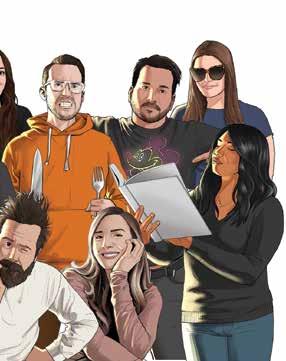
On the client front, the last year saw BHLA add brands like the Dairy Farmers of Ontario to a roster that already included Kids Help Phone, Everest Insurance, Kruger Products, MadeGood, Arterra and others.
In fact, BHLA is steadily booking work from its Liberty Village office in Toronto – even as storm clouds form on the horizon. This past year has been a tough one for tech and finance firms, inflation is depressingly high and stockbrokers the world over are betting on a recession next year.
But Chaney remains cautiously optimistic. “We’re working with clients to understand how brands succeeded in previous recessions,” Chaney says, “which is actually not to cut, but to invest.” BHLA is sitting down with marketing teams to find use cases and data to back up their case to brand’s CEOs for more robust ad spends.
It isn’t an easy conversation to have, Chaney acknowledges, but it is one that might be easier given the turmoil of the last two years: the pandemic may have desensitized CMOs to chaos. “I think there’s acknowledgement that it’s happening,” he says, “but I don’t think there’s quite the panic that used to exist in previous recessionary periods or tough economic climates.”
KEY NEW BUSINESS
Simplii Financial, Dairy Farmers of Ontario, Arterra/ Jackson-Triggs, GO RV’ing, Nestlé Carnation Hot/ Nescafé/Life Cuisine, Lactalis Cheestrings/ Black Diamond, Toys’R’Us, Simon’s, Pinterest, Peerage Realty Partners, Pulp Culture

NEW HIRES Tyler Robson, Jaimes Zentil, Craig McIntosh, Rasna Jaswal, Ravi Singh, Shannon McCarroll, Elma Karabegovic
1
1. See yourself at the ROM. Looking to entice visitors back in person, BHLA and the Royal Ontario Museum launched the “Immortal” campaign, which depicts a dramatic six-minute walk through history. Still in market, early results show general attendance up 65%, special exhibition attendance up 250%, ticket booking page traffic increasing by 85% and over 127M media impressions.
2. “It’s All Gravy,” BHLA’s most recent campaign for Air Miles, points to how the brand offers a little extra. It helped create a significant spike in the weekly reactivation of app users and a jump in weekly new app users (+256% since launch). Weekly web sessions rose 400%.

3
3. MadeGood’s “Unwreck the Future” campaign is a rallying cry to improve the world for future generations. It resulted in a 70% increase in dollar sales and helped the brand overtake Kellog’s Kashi as the number one organic granola bar in the U.S. market.

43Fall 2022 For full cases, go to agencyoftheyear.strategyonline.ca/winners
2
CASES
OFFICE Toronto STAFF 30
Small AOY Campaign of the Year
How (really) small agency Wunder is landing big brand work
 BY NICK KREWEN
BY NICK KREWEN
WUNDER IS NO LONGER A TWO-MAN OPERATION.
In fact, co-principals Stephen Flynn, CD and Mike Postma, director of strategy, recently doubled the size of the business by hiring a web developer and an account manager, simply out of necessity. Wunder has been creating some buzz of late. It needed the added bench strength.
Unlike many agencies, Halifax-based Wunder – named one of Canada’s top 20 agencies in the 2021 Strategy Creative Report Card – originated from a tech start-up that launched the mobile phone app, Tap.
“That’s how we ultimately ended up launching the agency,” says Postma. “That is where we got some of our initial clients from, too. We really spent a lot of time doing tech-heavy stuff for the first couple of years. We’re slowly but surely shifting
44 strategyonline.ca
2022 OFAGENCYYEARTHE SMALL AOY | SILVER
KEY NEW BUSINESS Assante, Relief, Asana, Domus Realty, Southwest Properties
NEW HIRES Cobie McFallon, Rylan Conway
OFFICE Halifax STAFF
the agency away from that direction and trying to free our time up to focus more on the marketing side of things.”

And Wunder has begun to land bigger assignments and briefs where they can show their chops doing integrated campaigns. Getting United Way Halifax in 2020 was a pivotal moment in the development of the agency. The last few months has seen the team produce its first traditional TV spot for the brand, which is slated to launch in time for the holidays this year.
Wunder also recently launched a fall campaign with Assante Wealth Management.
The campaign, “A Winning Retirement Plan,” focuses on the insight that some of us who aren’t super prepared for retirement often treat the lottery as a long-shot retirement plan.
“We launched an entire campaign to reach this audience that looks and feels like typical lottery ads,” says Postma, “but it nudges them to set up a meeting with an advisor to talk about retirement planning.”
Flynn notes that Wunder’s intimate size allows them to seize opportunities that might be overlooked by others. “Maybe a bigger agency doesn’t have the infrastructure to take a $20K or a $30K brief like we were taking in the early days,” he says. “But we were able to turn out some pretty awesome projects just because we were hands-on, nimble and scrappy.”
It’s probably one of the reasons why Wunder is picking up more and more work of late. Consider task management software company Asana. The client already had an agency focusing on the 360˚ brand via multi-milliondollar campaigns. But it tasked Wunder to create buzzworthy activations to drive earned media and talk value. For the “Work Worries” campaign, for example, Wunder built creative around the “Sunday Scaries,” reminding consumers that they can take control of their work future with Asana.
“We’re noticing that more brands are realizing that a single agency of record isn’t always the best way forward,” Postma sums. “So, we are starting to see more of those opportunities open up even for a smaller agency that big brands would normally maybe not have been comfortable with. What they’re after is great insights and good work. We’re very capable of doing that.”
CASES
1. Under the influence.
To drive brand awareness for microbrewery Good Robot, Wunder turned everyone and anyone into an influencer. “Micro-Influencer” asked customers to post and tag an IG photo with one of the brand’s beers, and in return, they’d receive an e-transfer of $1. Essentially re-framing the idea of a one-dollar-off coupon, the stunt netted the brand a 309% increase in IG mentions, $18.27 average spend per post and over 8M earned media impressions – not to mention tons of buzz across headlines.
2. Hinging on the popularity of Netflix’s Squid Game, “Recalling Cards” for debt reducing app Relief invited those in debt to feel more comfortable talking about what they owed. As a result, Relief saw a 125% increase in new debt enrollment.

3. Wunder’s research revealed that relieving financial stress leads to better sleep. Using this to Assante’s advantage, Wunder created “Sleep Well,” a series of components that drove home how the wealth management company could ease what keeps Canadians up at night.
For full cases, go to agencyoftheyear.strategyonline.ca/winners

45Fall 2022
4
1
2 3
For Calgary’s Daughter, it’s all about the A-team
CALGARY-BASED DAUGHTER CREATIVE HAS ALREADY done plenty to establish its design bona fides – but it’s increasingly becoming known as an agency to keep an eye on, too.
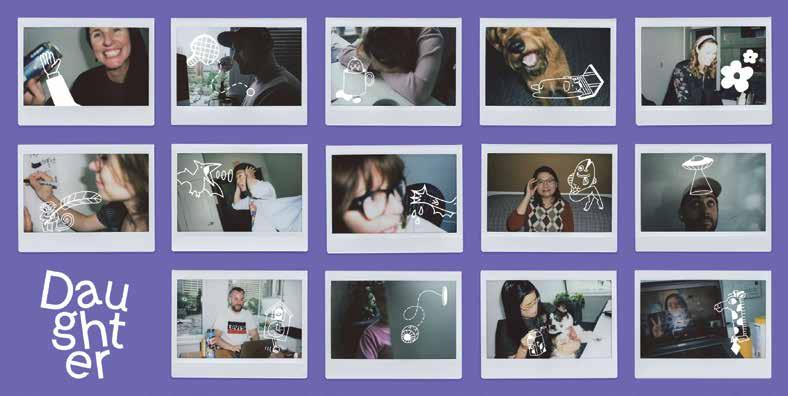
Daughter’s origins are in packaging and branding, having gained a reputation in the Calgary community for craft beer marketing with clients like Cabin Brewing, The Establishment, Annex and now Big Rock.
“We became really good at the design system,” recalls Jill Dewes, partner and director of client experience. “Because the breweries had set budgets, we had to create systems where we could turn a can [design] around in under a week with practically no budget. It put good discipline into the team. If we dig the well at the beginning and we create a system or a concept, executing it is easy.”
While those early clients helped Daughter hone its design chops, Dewes says it’s only recently that the
BY NICK KREWEN
advertising portion of their business has really taken off, too.
Becoming AoR for Calgary Co-Op, one of North America’s largest independent grocery stores, was an important step. Says Dewes, beating out more advertising-centric local agencies in a competitive RFP – including TV, radio, digital, out of home, etc. – was a real coup. As was landing comprehensive launch work for the Bow Valley College rebrand. Both got the agency plenty of notice.
“Clients really like the fact that we bring a lot of emotion to the work we do,” says Dewes. “They didn’t want to just be advertising stuff for a dollar off; they wanted to start connecting to their consumers. So, those really lifted our profile in the market from an advertising point of view.”
Recent big client adds include TransAlta (Daughter re-launched their brand in July, with a fall advertising
46 strategyonline.ca SMALL AOY | BRONZE + DESIGN | BRONZE (TIE)
2022 OFAGENCYYEARTHE
KEY NEW BUSINESS
TransAlta, NDAX, Big Rock Brewery, Vivo, Alberta Cancer Foundation, Business Council of Alberta, Numi Plaza Theatre, AltaML, Tenaris, connectFirst Credit Union, Arts Commons
Calgary
campaign running now) and connectFirst Credit Union (the agency launched a fall campaign for them as well, including TV, radio, digital and out of home).
Dewes describes Daughter’s superpower as being able to find the emotional connection in the work – and says that’s what has attracted clients to the agency since its 2016 inception. “We say to the client: it’s not, ‘Why are we doing a brochure?’
It’s: ‘What’s happening in your industry? What’s coming down the pipe for you? What do people want from you?’
“We look at things in a really human way.”
Part of that, she says, comes back to the size of the team and its ability to be as hands-on as possible.
The roots of that approach go back to when founder, partner and creative director Stephanie Kochorek – a Venables, Bell & Partners (in San Francisco) and Rethink Canada veteran – joined with Jonathan Herman to branch out on their own eight years ago.
“When you’re in a multinational, things are often quite slow,” explains Dewes, who joined the duo two months after launch, having spent the 10 years previous to that at BBDO. “There are lots of layers and processes, and you’re often not in the room where the decisions are being made.
“I think when Stephanie founded Daughter she really wanted to cut the layers out, be in the right room with the right people and have a seat at the table.”
Dewes, who became a partner two years ago following Herman’s pre-pandemic departure, says there’s no B-team at the agency. “At Daughter, we’ve got 13 people: three on the account service side and 10 creatives. So, it’s really heavily weighted on the creative side and that is very deliberate.”
SMALL AOY CASES
1. Designing a more inclusive future. The Calgary Foundation, a non-profit that aims to make the city more inclusive, wanted to use its annual report as an opportunity to highlight racial equity gaps. Through typography and design, “Shifting Perspectives” resulted in 100k web visitors and $100 million in contributions.

2. In an effort to build a brand identity while driving fundraising, Daughter launched a series of film, experiential and OOH spots, as well as a website, social platforms and merch line for OWN.CANCER.


3. Capturing the harsh realities of teen homelessness, Safe Haven Foundation and Daughter created “Streetfluencers.” Borrowing from the style of teen influencers on social media, the spot featured disturbing tips to maintain street safety overnight. The campaign resulted in $15k donations.
For full cases, go to agencyoftheyear.strategyonline.ca/winners
47Fall 2022
OFFICE
STAFF 13
1 2 3
DESIGN CASES



1. Leave your mark. A black foil-stamped cover with silkscreened thermochromic ink graced the latest “Vital Signs” – an award-winning report that measured Calgary’s quality of life. The remarkable execution was the representation of a year in which we didn’t hold our parents, embrace our colleagues, or touch the hands of friends.

2. The Ale Project created a new small-batch beer packaging system that helped consumers find local, experimental batch brands. It helped increase sales by 50%.
3. TransAlta’s new visual identity by Daughter is an expression of momentum – embodied by the brand in its transition away from fossil fuels towards renewable energy sources.

3
1
For full cases, go to agencyoftheyear.strategyonline.ca/winners
2022 OFAGENCYYEARTHE Go beyond your network. Tap into strategy’s audience to reach the most engaged and informed employees to find your next star hire. strategyonline.ca/careers






https://mediaincanada.com/subscribe/ All the media news you need. Replenish daily. Sign up for your free trial and stay connected with all the change afoot across the Canadian media scene.
Starcom works to embrace the benefits of shared experience
 BY PATTI SUMMERFIELD
BY PATTI SUMMERFIELD
STARCOM CANADA STARTED 2022 MORE UNITED and with a greater sense of purpose due in part to the shared experience of the pandemic, says agency president Christine Saunders. In fact, she notes, it offered a chance to consider how the agency functioned – both within teams and externally – and make some substantive improvements.
“We have all collectively been through a lot and have literally opened up our homes and hearts to each other,” she observes. “We had the opportunity to redefine what was important, both as an agency and as individuals. As an agency we listen more, make decisions based on person-first versus a collective, and are even more flexible and transparent than ever before.”
Starcom has been busy creating more collaboration within the organization, fostering a data and strategic-centric culture. For example, during the pandemic (as part of Publicis Media) it launched “PubliSees,” a playbook of thought leadership pieces shared with all clients to help them navigate these uncertain times. (The new resource will now be published quarterly.) The agency has also launched a DE&I Centre of Excellence that conducts regular studies to analyze changes in consumer behaviours – the latest putting the spotlight on new Canadians and how brands can better connect with them.
“One of the actions we took early on in the
KEY NEW BUSINESS Walmart, Metrolinx, Dairy Farmers of Ontario, TorStar Corporation, Align Tech, Lindt, Planet Fitness, Kicking Horse Coffee, Karsher, Government of Ontario, Ministry of Education
OFFICES Toronto, Montreal, Windsor, Calgary
STAFF
pandemic, and which will continue through a potential recession, is to stay on top of current trends and help our clients better understand and apprehend our changing industry and society,” she says.
To keep client relationships strong, says Saunders, the agency also went back to basics, creating a Planning Excellence Committee that met with every team to ensure each client was following proper fundamentals and working within the Starcom Human Xperience strategic framework.
And when it comes to the experience of those working at the agency, Starcom is doing everything in its power to be known as the place for talent. In fact, Saunders says talent retention and recruitment are two of the most important challenges she faces today.
To that end, the agency adapted a flexible work model, where talent can work from
50 strategyonline.ca
MEDIA | GOLD 2022 OFAGENCYYEARTHE
346
wherever is best for them. Going into the office is entirely purpose driven versus mandated. The team even has flexibility to work from anywhere in Canada and, for six weeks of the year, anywhere in the world. There was also a push for a salary adjustment for all employees to match inflation and, as part of Publicis Groupe Canada’s DE&I mandate, the agency launched several internal business resources groups – consider Viva Women, Publicis Parents and the Pan Asian Alliance – opportunities for employees to gather and reflect on current issues and topics.
Perhaps it’s not all that surprising that the agency was recognized as one of the Best Places to Work in Canada in 2022.

“We believe work is rewarding only if it is balanced with a strong personal life,” she adds. “That is why we praise flexibility and encourage our employees to dive into side hustles, take care of their loved ones, and be passion-driven. Each of these elements make them even better professionals.”
1. Get back in the game. The pandemic brought rec sports across Canada to an abrupt halt. So, to get men moving again, Kellogg’s Vector and Starcom Canada launched “Off the Couch,” an initiative celebrating the long-awaited comeback of rec sports. The brand saw a 21% increase in overall sales and 15% market share bump compared to the previous year. Paid media delivered over 29.5 million impressions. The campaign over-delivered on social, reaching more than 3.1 million active males on Facebook & Instagram.

2. To capitalize on pandemic renos, Lowe’s and Starcom created the colourful “Spoiler Alert” campaign that allowed consumers to choose paint colours from popular media clips. The socialdriven effort boosted sales in the paint department by 20% compared to the previous year, crushing the target of 16%.

3. Starcom worked with AR technology company GoSpooky to develop a firstof-its-kind lens that can recognize any model of Jeep by scanning the grille. Still in market, the campaign using the tech has already driven more than 34M impressions and 180,000 clicks and/ or swipe-ups. Over 79,000 people have engaged with the lens and it has been shared 35,000 times.
For full cases, go to agencyoftheyear.strategyonline.ca/winners

51Fall 2022
2
3 1 CASES
PHD leads with purpose – and lots of good intel
IT’S NOT NEWS THAT THE PANDEMIC CAUSED MANY AGENCIES to take a breath and analyze their approach to work and business. For an information-driven agency like PHD, that included making the right investments so that it was ready to roll with whatever came its way.

“Agility has never been more important,” says president Caroline Moul. “We definitely work in a more agile way in order to be able to meet our clients’ demands. Luckily, business has not slowed down, but that means there’s more pressure on our staff and we have to make sure our teams are equipped to handle it.”
Moul says PHD adapted by making investments –adding senior-level expertise and more capabilities in
BY LOUKIA PAPADOPOULOS
a variety of sectors, from data analysis to creative – in order to ensure brands were properly supported.
“For data and analytics, we put more focus on automation and data visualization, advanced analytics from attribution to audience analysis, and to rolling out clean room analysis,” says Moul. “We have seen progress when it comes to anticipating market conditions and what our clients will need to do to meet those conditions.”
Of course, it helps that PHD has access to proprietary tools inherited from holding company Omnicom – such as marketing science, advancing measurements from attribution modelling, consulting
52 strategyonline.ca
MEDIA | SILVER 2022 OFAGENCYYEARTHE
NEW HIRE Jamie Norgarb OFFICES Montreal, Toronto
and clean room analysis. For over a decade, PHD has collaborated with the mother ship when it comes to a planning operating system that’s now called Omni Studio. It’s a framework that integrates smart thinking, smart data and the knowledge of over 5,000 PHD employees around the world.
“Our approach is to make sure we’re able to plug and play with the data we have available as the landscape shifts,” she sums, “not only for analysis, but also in terms of how we can activate in the marketplace.”
When it comes to activations, Moul points to one in particular that she is especially proud of. “When you think about society coming out of the pandemic, everything is about being purpose-driven,” she says. “That is something we saw in our Dove “Detox” campaign.”
The Self-Esteem Project’s newest campaign, the work focused on fostering a healthier attitude toward body image that was more inclusive of all body types, not just those traditionally reflected in media. The campaign, called “DetoxYourFeed”, resulted from a research project that found half of Canadian teen girls are spending more time online with their friends than they are person – even though half also say the toxic
beauty guidance they’re fed through their social media streams is hurting their self-esteem.
The campaign launched internationally with a spot called “Toxic Influence,” in which a group of mothers are exposed to the harmful advice their teen daughters are receiving – which then becomes further personalized when they, themselves, appear to be giving the advice through the use of deepfake technology.
Moul points to the campaign as one of the agency’s most innovative last year. “It was an opportunity to stand up for something and we are incredibly proud of that work,” she says.
Expect PHD to focus further on skills, data and technology to power its creative in future in order to be ready for whatever comes next.
“As industry changes happen, we want to be at the forefront of all developments,” she asserts. “In the last 12 months, we’ve really doubled down on commerce, both in talent and tools, and that is a trend that’s set to continue. We are also really excited to see how Web 3.0 will shape up and what that will mean in terms of developing capabilities, whether that be NFTs or the metaverse, or something else entirely new.”
CASES
1
2. Unilever’s Dove “#DetoxYourFeed” campaign used deepfake tech to show moms the toxicity of social media for girls. It reached the parents of well over 3.5M Canadian girls and landed over 19.5M earned impressions.

2
3. PHD and Google rolled out “For All You Are” to promote the translation capabilities of the new Pixel6 phone –becoming the first Mandarin ad ever to air on English TV in Canada.


3
1. A colourful exchange.
Each year, SICO has welcomed new competitors to its home turf of Quebec. So it was important to create a campaign that could create passion for the brand. SICO “Shades That Show Your True Colour” spoofed the absurdity of paint names, using cultural references and colourful French language. It had a dramatic effect on the local brand’s consideration in Quebec: awareness hit 97% and consideration 74%, a peak in the province.
53Fall 2022 KEY NEW BUSINESS
Chanel, Unilever, Popeyes Louisiana Kitchen
STAFF 194 For
full cases, go to agencyoftheyear.strategyonline.ca/winners
Touché: Driving innovation through data
BY LOUKIA PAPADOPOLOUS
FOR TOUCHÉ, THE TAGLINE “Fueled by data. Driven by creativity” isn’t just a nifty catchphrase. Some of the agency’s best work over the last year clearly demonstrates a clever combo of innovative creative and even better targeting. Case in point: Touché secured its place in the Media AOY awards for the third year in a row largely thanks to three campaigns: Wilson’s “Bugs Out!,” BRP-X’s “Uncharted Playgrounds” and Atmosphere’s “Camping Rituals.”
“They are great examples of how we use the global tools created by the network and leverage them locally to create impactful, data-fueled media campaigns,” explains Touché managing director Samantha Kelley.
“Omni, our people-based marketing platform, combines two key components: an identity graph
(future-proofed because it is people-based, yet entirely privacy compliant and non-reliant on cookie-level data) and an inventory graph (a comprehensive marketplace of media inventory). It was at the core of the audience creation for these three campaigns, and it doesn’t get any more targeted: bug-infested neighbourhoods, mud lovers and camping rookies and veterans.”
All three campaigns demonstrate how creative, data and strategy can come together to create breakthrough campaigns. And that’s nothing new for the agency. Touché has prided itself on redefining what creativity means for over a decade now.
“We recently reviewed our most-awarded campaigns over the last decade,” says Kelley. “In 2010, our first internationally acclaimed campaign featured heated
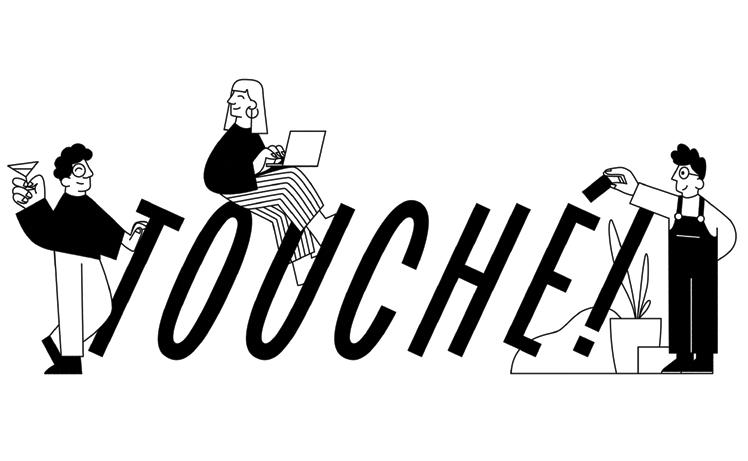
54 strategyonline.ca
MEDIA | BRONZE 2022 OFAGENCYYEARTHE
KEY NEW BUSINESS DraftKings, WestJet, Loto-Québec, Cascades, New Look, STM, Guru, Breakfast Club of Canada
NEW HIRES
Warren Ravinsky, Vahini Jeevakaran, Vincent Marois, Kelly-Anne Hamilton, Nadiia Khoteniuk, Nathalie Bilodeau, Cecilia Kyriazis, Alan J. Merrick, Samar Majali, Daniyal Shaikh, Courtnet Rosebush
OFFICE Montreal STAFF
transit shelters [covered by] a toque. Fast forward to this year and our award show headline was Wilson’s “Bugs Out!” that used the power of predictive analytics.” Knowing where bug infections would happen before they were a problem allowed the brand to be on the spot with its messaging before its competitors were even warming up.
Touché isn’t just adapting to innovations in media, she says, it wants to lead them. And that comes down to talent and how well they are supported. The Touché clan has access to initiatives such as an internal mentorship program – which recently saw more than 40 mentors and 90 mentees sign up – or training programs like OMGcoach and U2THEMAX, which help each team member continue to develop their hard and soft skills at every stage of their career. The agency also recently launched a unique recruitment and retention campaign backed up by employee testimonials.
Clearly, the talent brings the creativity – but where does the data to fuel it come from? OMG has integrated market-leading data partners such as Environics, Lotame, Pelmorex, Numeris, Vividata and Comscore, and built a completely unique, made-inCanada data solution.
“All data is brokered by our OMG Centre of Excellence team in Canada,” explains Kelley. “We do not [want to rely on] our own data, as that does not provide the flexibility to access the best, latest and most relevant data in the market. Our “no data stake” approach allows us to gather a market-leading collection of data sources. The sum of all data parts is an identity graph that has thousands of consumer attributes. All of which power the Omni tool that Touché then builds audiences in.”
So, what does the future hold? In the next year the agency is aiming for a 20% growth in staff for its Toronto office – a critical part of its growth strategy which will help drive future success, says Kelley. It also wants to keep on redefining what creativity and innovation mean for its clients, putting to market campaigns that earn consumer attention. “By doing so, we will be staying in the top 10 most-awarded media agencies in the world,” she concludes.
CASES
1. Sharing great intel.
For the last 20 years, off-road adventures have become harder to come by. So, BRP wanted to create a way for riders to share great circuits. To do so, it created Uncharted Playgrounds – an online booking system that connects riders to landowners. The campaign has seen bookings increase by 56% while doubling the number of active regions in the platform – and the number of available playgrounds has increased twofold. After less than a year, the community has already expanded to new international markets.

Media Campaign of the Year
2. Atmosphere and Touché created “Camping Rituals,” an effort aimed at helping outdoor vets pass their skills to new campers. The campaign helped boost camping category in-store sales by +40% and online sales by +161% – and reached more than 2M Quebecers.
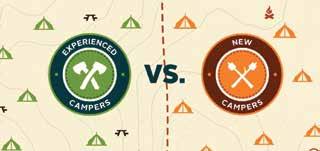

3. Wilson’s “Bugs Out!” used data to better target consumers in areas historically likely to be hit by bug infestations.
For cases, go to agencyoftheyear.strategyonline.ca/winners
55Fall 2022
263
3
2 1
2022 OFAGENCYYEARTHE
KEY NEW BUSINESS Adidas, Hershey Canada, PlayStation, OLG, Voilà, Coinsquare, Shopify, Pocket Health, Sobeys/ Safeway, Rachelle Béry, Valentine
NEW HIRES
Leo Barbosa, Cuanan Cronwright, Rosie Gentile, Gillian Morrison, Sam Cote, Ryan Dzur, Geoff Mack, Eric Carriere, Michael Carey, Cathy Barbarossa, Erikson Melton, Sanjam Hundal, Stephanie Page, Afton Franklin, Melissa Legault, Shayne McDonald, Ghaith Rajeh, Jesse Gilbert, Paul Hanlon, Mary Koerner, Jennifer Cialini

FCB relies on co-creation to kickstart innovation
FCB CANADA’S CORE OBJECTIVE as an agency is as ambitious as it is simple: do the most innovative work in the business.
“None of it is easy, but we’re not afraid to do the hard stuff,” says Nancy Crimi-Lamanna, the agency’s CCO. “If we need to build something, we will build it. One of my favorite sayings is leap and a net will appear. You have to make that leap and trust that you will find the solutions and people to help you make it happen.”
Despite the difficulty of its goals, FCB hasn’t had an issue “making it happen,” winning Digital Agency of the Year Gold six times in seven years (it’s returning to the top of the podium after a Silver win last year). Some of that innovative thinking comes from the company
BY JOSH KOLM
culture at FCB, but to be successful, it also needs to be baked into the agency’s processes, people and the way they work together.
In the spring, Eli Ferrara moved from leading new products and partnerships at creative data agency FCB/Six to a new VP of creative innovation role at FCB Canada. The job has Ferrara sitting within the creative department, providing advice on the latest media platforms, technologies, data practices and tech conventions that could help with a client objective or really bring a creative idea to life.
Crimi-Lamanna says that means Ferrara works with teams across FCB Toronto, FCB Montreal and FCB/Six, but also with clients to present them with
56 strategyonline.ca DIGITAL | GOLD
OFFICES Montreal, Toronto STAFF 284
new opportunities and ways of thinking. She credits the approach for projects like “BMO NXT LVL,” a series of Twitch live streams in which one of BMO’s own bankers chats with experts on personal finance subjects as they play a relevant game.
Digital integration at FCB goes beyond one role, but that one role is emblematic of the broader approach the agency takes to innovation.
“We’ve really worked hard to make sure that we didn’t fall into that agency trap of having standalone and siloed offerings,” says Bryan Kane, president of FCB Canada. “A big part of that is co-creation. It’s not like one art director or writer comes up with an idea. It’s bringing subject matter experts from data or culture or technology to build on ideas as they’re forming, as opposed to them being add-ons to an idea. Something that has been key to our most innovative work was a number of people with diverse specialties that iterated on an idea to ultimately make it what it was.”
A lot of agencies tout tech-forward or data-informed creativity, but few are clear on what that actually looks like. In FCB’s case, part of the process is baking in an openness to different perspectives and possibilities.
“It has to be malleable and flexible,” Crimi-Lamanna says. “Sometimes, your expert comes in on the brief and works with the team. Other times the team has an idea already and realize they need to pull UI experts or resources from FCB/Six into the fold and to figure out how to make it happen.”
FCB has also recruited a fair share of its own experts this year. The creative team has grown the most, but there have been senior hires across the group, including long-time Cossette exec Rosie Gentile coming on to oversee FCB/Six. Kane says a “diversity of thinking” is core to the way FCB works, and its creative accomplishments have made it an attractive place to work for people from a range of backgrounds.
“From a data and tech perspective, we’ve been able to recruit people that want to work in a creative environment with differing perspectives they can draw upon,” Kane says. “That collaboration and co-creation type of idea is what’s drawing people to FCB. We’ve had a number of really deep subject matter experts that have worked in highly specialized environments, but were yearning for applying their skills in a creative environment.”
“Data and tech is nothing without a human application,” Crimi-Lammana adds. “I think that’s what people get excited for when they’re coming to FCB, adding that emotional element or human connection to data and tech in ways that haven’t been done before.”
CASES
1. Making space.
For “Runner 321,” adidas and FBC asked the world’s largest marathons to reserve bib number 321 for people with Down syndrome, highlighting how they are often excluded from sports. To date, over 100 athletes have signed up and all six of the world’s largest marathons — London, Chicago, Berlin, Tokyo, New York and Boston — have agreed to hold a spot for runner 321.

Digital Campaign of the Year
2. For OLG, FCB created the LOTTO MAX “Dream Drop” clothing line to shore up its player base and target a younger demo. The campaign realized a 200% ticket sales increase over the first three weeks, 10 times the objective.
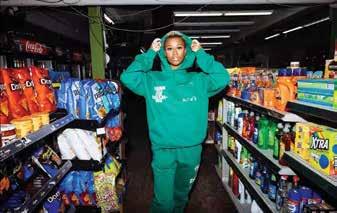
3. BMO needed to connect with a new generation of customers. Enter “NXT LVL” — a first-of-its-kind Twitch channel intended to educate users on money matters.
For full cases, go to agencyoftheyear.strategyonline.ca/winners

57Fall 2022
1 2
3
McCann flexes its creative muscle
 BY PATTI SUMMERFIELD
BY PATTI SUMMERFIELD
MCCANN HAS BECOME ALL ABOUT tearing down boundaries, whether they happen to be geographic or philosophical.
Says Ryan Timms, president of McCann Canada, “We’ve fully embraced our remote business transformation, being able to leverage some of the more sustainable practices that the pandemic thrust upon everybody and make them part of the future going forward – and there’s no reason to go back.”
The agency has forged a high degree of connectivity across its Montreal, Toronto and Calgary offices – thinking of them as a cohesive team rather than Toronto being the hub for the agency – and is thinking even more about how it can bring more value by working with the McCann team internationally. It’s bigger-picture thinking spurred on by a combination of recent world events, changes in consumer behaviour and the demands of ever-evolving technology (consider the deprecation of the cookie).
Says Timms, going forward there needs to be more
consideration placed on how brands are interacting with consumers in their day-to-day lives – and agencies need to think more holistically. “We simply can’t be overly reliant on standard paid media channels,” he says. “We need to keep finding ways to help our clients break the mold when it comes to what their audiences are accustomed to.”
Recent work the team did for the launch of the new Wendy’s app is an example. Instead of advertising the app (which, let’s face it, no one really gets all that excited about anymore), it launched a completely new phone to tap into the hype that surrounds such technology launches. (The team even designed a custom Wendy’s A.I. for the device that was able to bring the personality of the brand to life.) Outside of the paid media support, the launch garnered over 14 million earned impressions and a 240% increase in mobile transactions for Wendy’s.
Says Timms, successes like that are in no small way being driven by cultural shifts and changing consumer
58 strategyonline.ca
DIGITAL | SILVER 2022 OFAGENCYYEARTHE
Canada, Xplornet, Melanoma Canada,
Toronto, Montreal, Calgary
expectations about what brands do. McCann does extensive research year-over-year and throughout the year, and recently dug deeper to look at how attitudes of Canadians had evolved post-pandemic. What they saw was a rise in expectations: consumers expect brands to bring more value to their lives – and even make the world a better place.
To that end, he points to L’Oreal brand Nyx cosmetics, which has a history of supporting the LGBTQ+ community. The brand's stores in the U.S. are all designated safe spaces – places where staff are trained to be able to help and support the LGBTQ+ community. But the closure of so many bricks and mortar locations forced many members of this community to feel a greater sense of isolation. So, McCann created virtual safe spaces with licensed accredited counsellors, influencers and celebrities within the LGBTQ+ community to offer support and connection.
“For us, we think that’s where we live as a creative agency supporting our clients – how you can bring a brand closer to the belief and expectations that Canadians have of them. Brands need to show up and demonstrate the value they can bring, not just talk about it,” says Timms.
On the global front, McCann came up with an idea for Mastercard to work with navigation and traffic app Waze to help consumers identify which grocery stores were least busy during the pandemic so they could better decide when to do their shopping. The idea for Safe Waze 2 Shop came from a Canadian creative team, but was executed with McCann’s colleagues in Poland.
Canada also worked closely with another McCann international team – McCann London – on all things Skip the Dishes/Just Eat Takeaway. In addition to developing original work for Canada to support the Skip hockey platform, the agency adapted and built additional campaign elements to support the debut of Skip’s “Snooperbowl” campaign prior to this past Superbowl’s halftime show, as well as the follow-up campaign that features Katy Perry.
“I talk about our connectivity in our offices here in Canada,” says Timms, “but for global agencies like McCann, that’s a real muscle we get to flex more: How we can tap into that global bench even better than we have in the past to create more opportunities for creative thinking and contribution from here in Canada, and impact what happens in other countries in the world.”
1. Breathe easier.
For World Lung Day, the Canadian Lung Association and McCann unveiled "Lungs in the Air," a travelling art installation supported by an aggressive PR strategy and digital presence. Visible from 50 miles away, the fourstory-tall inflatable lungs soared high above cities across Canada, while the campaign used social posts and on-site QR codes to drive audiences to LungsInTheAir.ca — achieving 17 million PR impressions in 10 days.
2. McCann and the Royal Canadian Mint urged Canadians to "Re-Sail the Race" for the new Bluenose coin. The effort shifted share of positive brand sentiment from 44% to 97% — helping earn a 10% increase in Canadians’ belief that commemorative coins are an effective way to instill national pride.

3. Wendy’s phone launch to promote its new app turned into 14 million earned and organic impressions, and spurred more than 40,000 new app downloads in the first week alone. The brand saw a 250% year-overyear increase in mobile transactions per store.

For full cases, go to agencyoftheyear.strategyonline.ca/winners
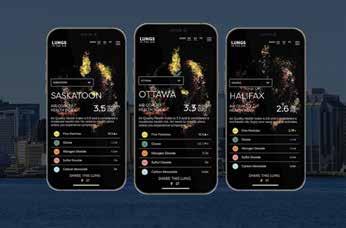
59Fall 2022
2
1 3 CASES KEY NEW BUSINESS Club Med
AGLC OFFICES
STAFF 216
2022 OFAGENCYYEARTHE
|
KEY NEW BUSINESS
Domino’s Pizza of Canada, Lactalis, Groupe St-Hubert, Brault & Martineau, Loto-Québec, Fonds de solidarité FTQ, Ministère de la santé et des services sociaux du Québec, Mondoux, Groupe Maurice
Montreal, Toronto, Quebec City
STAFF
Lg2 won’t stray from its grand designs
BY JOSH KOLM
IN THE SIX YEARS THAT STRATEGY has been awarding Design Agency of the Year, Lg2 has been among the winners five times. That kind of recognition seems obvious for an agency like Lg2, which has built a reputation for its design chops over the last 30-odd years.
Lg2 was one of the first agencies in Canada to offer a dedicated branding and design service, as opposed to it being an add-on to other creative services. Today, its expertise touches on everything from traditional graphic design and branding, to UX and UI, to architecture and interior design. Its projects this year included pasta packaging, building a new eyewear store and a digital platform to help people discover the
stories and attractions shaping Village Montreal, the city’s 2SLGBTQ+ district. Claude Auchu, the agency’s CEO, is also a designer by trade, and even maintained his head of design duties for a time after first becoming the agency’s executive director.
The passion for design is clearly baked into the agency’s history – and it comes from the top down.
And that has remained true even as creative agencies – Lg2 included – have made more investments into digital capabilities and innovation.
“Marketing approaches and channels are everchanging, but at the core of everything is the brand, guided by strategy and crafted by designers,” says Ryan Crouchman, Lg2 partner, VP and ECD of design. “The language of design has always connected with people on various levels – some rational, others emotional, and it’s our job to make sure we build brands that can do both, and then have fun expressing them in different creative ways based on the brief tactics and media plan.”
Crouchman describes Lg2’s philosophy towards design as symbiotic with the opportunities an agency pursues.
“Good design in 2022 requires the same core element as in any previous era: empathy,” Crouchman
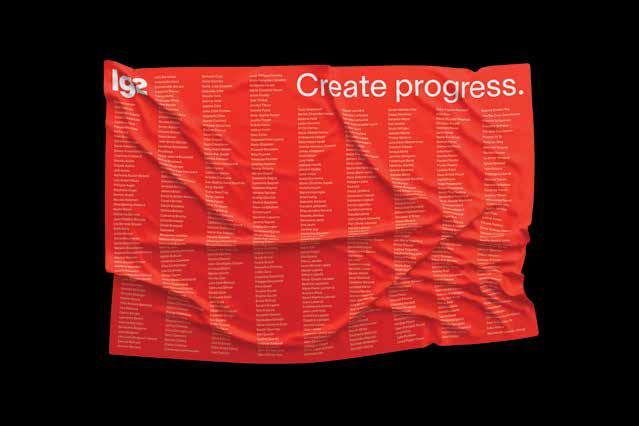
60 strategyonline.ca
OFFICES
500
DESIGN
SILVER
says. “Design has always been about responding to a particular set of needs, so in a way it is innovative by nature. The more we innovate, the more we need responsive design solutions.”
To see evidence of this, one needs to simply look at the market. Lg2 hasn’t necessarily been getting less design briefs in favour of more digital-focused ones, though there is one thing Crouchman says is in particularly high demand.
“Clients today expect more integrated brand projects,” Crouchman says. “And this requires our designers, digital art directors, motion designers, copywriters, content strategists and even our in-house architects to work hand-in-hand. These collaborations are truly exciting for everyone involved, because they are so multi-layered and rich. The teams inspire and push one another, and it always shows in the final work.”
Other than design, Lg2 has also developed a reputation for making moves to ensure its status as Canada’s biggest independent agency doesn’t change. The latest came in June, when it established a board of directors made up of a mix of agency partners and external business figures, led by former Desjardins CEO (and one-time Lg2 client) Monique Leroux as chair.
The move was a rarity, both in the agency sector and among Quebec-based small businesses, both of which rarely see non-investor members sit on the board of a private business. But Auchu told strategy at the time that, in addition to helping the agency stay independent, it is just good governance that would keep it in touch with stakeholders to help with professional development, strategic planning and taking on new opportunities.
While the agency is looking to the future, it doesn’t seem likely that it will stray from its roots as it does so. It can sometimes seem like the rush at agencies to bolster their digital transformation and data capabilities is putting them at a distance from the industry’s roots in design. It’s still important, to be sure, but design is still old school: nice to have and pretty to look at, but it’s not the star of the show. Data and technology are the future – they’re how agencies can move upstream with clients to take on transformative projects, and are the only way to unlock the kind of one-to-one connections marketing departments are clamouring for.
According to Crouchman, that dichotomy is a false one.
“Design always has inputs and outputs,” he says. “Data provides insightful input, and new technologies offer exciting output. At the end of the day, if the work is not thoughtful and well crafted, it will fall flat, so we always need to stay focused on creating smart, beautiful and enduring work that will, above all, connect with people.”
CASES
1. Not playing games.
When Ludia, one of the biggest mobile game studios in Canada, wanted a rebrand, Lg2 decided to break out of the norm and create an identity that accurately reflected the fun and innovative nature of the studio. It wanted to generate excitement and convince new talent that Ludia was the place to work. Mission accomplished: the studio doubled in size within the last year and a half, attracting over 150 new talents.

2. Lg2 repositioned Montreal’s 2SLGBTQ+ community into “Village Montreal” to better embody the diversity of the neighbourhood. The resulting branding and media turned the Village into the talk of the town, despite a low budget for the campaign.

3. The Espace GO theatre team wanted to reposition its brand to move closer to its original vocation: “a place dedicated to theatrical work from a feminist perspective.”

A new brand platform and other projects have seen them reconnect. The website, for example, has seen visits increase 34.25% compared to the previous season.
For full cases, go to agencyoftheyear.strategyonline.ca/winners
61Fall 2022
2 1 3
OFAGENCYYEARTHE
Cossette emerges from a tumultuous
GIVEN THE LEADERSHIP CHANGES Cossette has experienced over the last year, perhaps it’s not surprising that, when he was asked about the biggest challenge the agency has faced of late, president (Ontario and West) Daniel Shearer had a simple answer: “People, people, people.”
For Shearer, it’s become all about finding the best talent and making sure they have both the space and the backing they need to be successful.
“We have never been more focused on supporting our people through the mental health challenges of being working parents with kids yanking at their shirttails every five minutes,” he says. “Or of living alone and struggling with pandemic loneliness and isolation. Or living in multi-generational households where there just isn’t enough space to jump on a phone call. Trying to provide consistency and quality to our clients in those
conditions has been a unique challenge.”

But, despite these and other hurdles, Cossette has attracted top-drawer talent over the last year who will help shape the agency for years to come.
After several months and an extensive search, for example, Cossette recently named Sabaa Quao as its new CCO. Quao brings three decades of entrepreneurial experience in Canada and Europe, building platforms and companies in the tech, content and cultural spaces, to the role. That news came only weeks after the agency hired a swath of senior creatives to work on the McDonald’s Canada account, led by new ECD Jason Hill.
Then there’s Jessica Borges, who now heads up Cossette’s multicultural practice, Koo. Or consider Max Macbeth, who will lead strategy in the Vancouver office, and Montreal-based Louis Mathieu, who
62 strategyonline.ca
DESIGN | BRONZE (TIE) 2022
with several key wins
KEY NEW BUSINESS Indigo, Movember, Ledn, Pacific National Exhibition Playland, VGH, UBC Hospital Foundation, AAA Heidelberg
OFFICES
Quebec City, Montreal, Toronto, Halifax, Vancouver
becomes head of digital strategy for the agency.
Despite all the senior personnel changes and challenges that came with them, the agency kept right on trucking over the last year – including some exciting new business wins. Indigo named Cossette as its AOR just in time to help it celebrate its 25th anniversary. BRP also signed on, giving Cossette exposure in the 117 markets in which its products are sold.
Then there’s Google, for which Cossette is working on the YouTube and Pixel 6 accounts. And, to top off the list
BY WILL NOVOSEDLIK
of new clients, Weight Watchers (now branded WW) and Quebec Tourism added their names to the roster.
But don’t expect the agency to dwell on the year that was or to shy away from more change if it helps the agency grow. Now in its fiftieth year, Cossette is firmly focused on the road ahead.
Says Shearer: “We’re taking this milestone as a natural opportunity to look at the next five, if not 50, years. You can expect to see lots of change.”
1
1. Canadian media comes first.
Cossette designed a Canadian Media Manifesto for the CMDC that uses danger-sign starkness to radiate urgency and enlist investment in local media organizations. As a result, almost 600 media directors have pledged to support the campaign and buy local.

2. For the Bentway Conservancy, a 169,000-sq-ft public space located under Toronto’s Gardiner Expressway, Cossette created tons of original art, as well as a wayfinding and design system that encourages exploration and engagement.
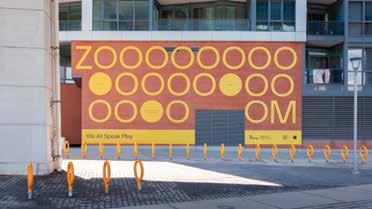
3. Cossette recently helped the World Anti-Doping Agency update its image using playing field imagery that conveys the fair play conditions the organization represents. Launched in January 2022, the transformation has made the branding far more memorable.

63Fall 2022 For full cases, go to agencyoftheyear.strategyonline.ca/winners
2
CASES
STAFF 634 year
3
PR agency Middle Child is disruptive by nature
 BY CHELSEA CLARKE
BY CHELSEA CLARKE
IF YOU CAN COUNT ON A CATALYST TO SHAKE things up, it’s Middle Child. No, we’re not talking about the second born (although good luck to you if that describes your situation) – this capital M, capital C Middle Child is the PR agency that recently spurred conversations around heavy hitting campaigns such as Kraft-Heinz’s Hot Dog Pact and Kraft Peanut Butter’s Storybook.
The self-proclaimed ‘agency that refuses to be ignored’ prides itself on creating work that disrupts the industry, taps into cultural conversations and drives impactful conversations. “We call ourselves culture hackers not because we tell stories about what’s already happening in culture, but because we intercept conversations, with our brands as champions, changing the narrative and making headlines that demand attention and disrupt newsfeeds,” says Middle Child SVP, Katie Muir.
In the case of Heinz’s Hot Dog Pact, a collaborative campaign that aimed to rectify the controversial injustice of wieners coming in packs of 10 but hot dog
buns in packs of eight, Middle Child sparked the conversation by partnering with TikTok influencers to create dramafilled viral videos. The campaign earned 2,308 media stories, 1.55B impressions across the globe and even had Stephen Colbert talking. (Hint: Want the secret sauce to reaching Colbert-level fame? Muir says it was a mix of playing into the ongoing debate regarding the subject matter while hitting the right cheeky tone that could get people giggling.) In response to the most successful earned campaign in Heinz history, Wonder Bread launched 10pack buns in June 2022.
Middle Child is female-founded and female-operated, and the agency makes a point to hire thought leaders from all backgrounds. “Building a network of individuals from different backgrounds with diverse perspectives and experiences has led to rich discussion, engagement and program ideation. It’s been the driving force behind some of the incredible stories we’ve been able to share this year, many of which highlighted communities that are marginalized or underrepresented,” says Muir.
“In the last year, our agency has been able to work in partnership with these communities to tell women-led stories, LGBTQ2I+ stories, BIPOC stories, and many more. These are amongst our proudest achievements and will continue to be work we prioritize.”
64 strategyonline.ca
PR | GOLD 2022 OFAGENCYYEARTHE
NEW BUSINESS
Dairy Farmers of Ontario, L’Oreal
NEW HIRES
Joseph Crimi, Taralyn Kerr, Bea Ticsay, Gabrielle Lamy, Sara Pappas
OFFICES Toronto, Montreal
These values were in line with Kraft Peanut Butter when it launched its Storybook campaign. Aiming to normalize the conversation around pronouns, acceptance and inclusivity, Middle Child and Kraft Peanut Butter, along with interagency partners, created the children’s storybook, His, Hers, Them and Theirs: Learning Pronouns with the Bears, literature that aided dialogue between parents and children.

To support the campaign, transgender author Nick North visited nearly every major broadcast outlet across Canada to read excerpts from the book and drive awareness of Kraft Peanut Butter’s initiative in support of the LGBTQ2I+ community. The book sold out in just 24 hours, and Middle Child received a call from the Library Archives of Canada requesting a copy to preserve in Canadian Literary History. “It’s campaigns like this – that shift the narrative, change perceptions and make a true impact – that make our jobs as storytellers so rewarding,” says Muir.
There’s a saying within Middle Child: “If the current model doesn’t fit, break it.” This philosophy comes into play not only in its creative, but also in the agency’s operating
model. Last year, Muir and business partner Amanda Shuchat announced a co-leadership structure that flips the idea of single-CEO leadership on its head. Instead, the pair each own different aspects of operations, giving them enough time to dedicate to their young families. “This is just one example of the type of transformational shifts we hope to implement to create space for women in the industry – at all ages and stages of life,” says Muir.
This year, the agency saw massive growth, winning clients such as L’Oreal, Dairy Farmers of Ontario and Coca-Cola Bottling, as it sets its sights on broadening its client base, expanding its existing specialties (like digital and event management), and increasingly going borderless, riding the wave of sparked conversations that reach south of the border.
While these accolades are admirable for the agency, it’s the nature of the middle child that perseveres: To be curious, full of wonder and notoriously attention seeking, according to Muir. “It’s not about driving impressions – it’s about starting and fostering conversations. We go about it differently, often unapologetically, and we refuse to accept the status quo.”
CASES
1. Let’s give buns something to talk about.
1
To get people talking about Heinz’s solution to an ongoing point of BBQ contention, Middle Child enlisted the help of TikTok influencer Lubalin to recruit more people to sign the “Hot Dog Pact” on Change.org, and sent pitches to Stephen Colbert and hard-hitting news desks. The campaign generated over 1.55B earned impressions, 2,308 earned media stories, exceeded KPI by 948% and made history two-times over: not only was this Heinz’s most successful earned campaign to date, but it also changed hot dog history – Wonder Bread started selling 10-pack buns as of June 2022.

2. Middle Child set out to separate fact from fiction when it comes to what it truly takes to be a Guinness World Record holder. For this campaign, they sparked conversation on TV spots and tours, turning a miniscule budget into over 155 million earned media impressions.
3. Kraft Peanut Butter wanted to help parents discuss inclusivity with their kids. With Middle Child’s help, the storybook generated 19.4M earned impressions and has earned a spot in Canadian Literary History.
PR Campaign of the Year

65Fall 2022 For
full cases, go to agencyoftheyear.strategyonline.ca/winners
KEY
STAFF 30
2 3
No Fixed Address fuels quick expansion with entrepreneurial spirits
BY NICK KREWEN
SINCE IT LAUNCHED IN 2016, Toronto-based No Fixed Address has grown from two partners with a shared vision to a full-service, going concern that’s home to more than three hundred across its many offerings.

NFA offices can now be found in Montreal, New York and Chicago – in fact, half of the collective’s overall business is coming from the U.S. – and the agency family has grown to include Toronto-based multicultural agency Ethnicity Matters and Courage north of the border, and New York-based Mischief to the south. The latest news is that all four agencies can
be found under the umbrella brand “The Grid,” though each will continue to operate as distinct entities.
NFA – which has previously won Silver and Bronze in the AOY Digital category and Gold in PR – now works with 65 clients around the world. Its collective and integrated services include media, public relations, digital, data, analytics and a thriving health division – and it has set a new benchmark by recognizing the importance of speaking meaningfully to multicultural audiences.
And the collective is very much in growth mode. This
66 strategyonline.ca
PR | BRONZE 2022 OFAGENCYYEARTHE
KEY NEW BUSINESS
Beyond Meat, Betway, Chef’s Plate, Kraft, Freed Developments, Canada Learning Code, CPA Ontario, Royal Ontario Museum, CMHC, Hivestack, Eli Lilly, VRAYLAR, AbbvieAllergan, Insurance Store
NEW HIRES
Anand Iyer, Dominique Raso, Chris Perron, Jay Fleming, Hayley Malcho, Holly Lepp, Caitlyn Kirkos, Andrew Rizzi, Daniela Angelucci, Jared Kwart, Aryana Hassan, Alina Stanca, Victoria Di Valerio, Jennifer Mo, Alex Berube, Brittany Dow, Vanessa Côté, Michelle Hayos
OFFICES
Toronto, Montreal, New York
year alone, NFA brought on a new team of CRM experts led by Priyanka Goswami, added four senior leaders to its Health division, bumped up the capabilities of the PR team with several important new hires, and restructured the Ethnicity Matters team to include three new managing directors.
The NFA leadership team includes founders Dave Lafond and veteran executive Serge Rancourt, with ex-BBDO New York CCO Greg Hahn brought on to establish New York-based Mischief in June 2020.
When asked about all the growth, Lafond says he figures the collective’s rapid success boils down to one thing: its entrepreneurial spirit.
“We set out to do it differently,” he explains. “The heart of the No Fixed Address mindset was to be unbound, because with the big agencies it had become very formulaic. I thought, we need more flexibility. That’s where we took the ingredients for our entrepreneurial spirit and our calling card – that freedom to be fearless.”
And Lafond says there’s hunger for yet more growth – joking that “NFA” might also stand for “No Fixed Approach.”
“Serge and I had big ambitions and we both had run big agencies. So, we understood what it was going to take: you get the top talent, you get the clients and then you do great work. Then the momentum fuels itself.
“We didn’t have a marquee client when we started. So, we spent a lot of time on the narrative and the type of talent we wanted to bring in. We were very fortunate to pick up Questrade about the same time we launched. That was our jet fuel.”
The NFA client base quickly grew to include J.P. Wiser’s Whisky, the Canadian Centre for Child Protection, radio station Boom 97.3, Disney, Ryerson DMV, Sunnybrook and North American home builder Mattamy Homes, among many others. Recent additions include the Canadian Real Estate Association, Ivey Business School (with Angry Butterfly) and George Brown College.
“From what I see, we’ll keep scaling,” Lafond says of the future. “But we follow our clients: we don’t necessarily follow a city or a capability.”
CASES
1. Show your strength. In just two weeks, the Terry Fox Foundation blew past expectations with the opening of NFA’s “I’m Not a Quitter” campaign, a collaboration with novelist Douglas Coupland. Within 24 hours, the TFF sold more than 6,000 shirts (crashing the site twice due to traffic volume during a Breakfast Television segment), and it increased early registrations by 152% compared to 2019, which was previously the highest year. The campaign garnered more than 145M impressions and raised more than $300,000 for cancer research.

2. To drive relevancy during the pandemic shutdown, NFA worked to develop the ROM’s first-ever crowdsourced exhibition, with children’s artwork describing the COVID-19 experience. During the campaign, social engagement was at an all-time high, with a 732% increase in mentions and a 17% increase in site traffic, 91% of which were new users.

3. NFA worked with the Canadian Centre for Child Protection on “Unwanted Followers” – a hard-hitting campaign that tells the real story of victims whose abusive imagery continues to exist online. The campaign has been organically viewed by more than 800,000 people and amassed more than 17M global impressions.
For full cases, go to agencyoftheyear.strategyonline.ca/winners

67Fall 2022
STAFF 162
2
1 3
THE 2022 AWARDS PROGRAM BEGAN with an open call for Canadian agencies to submit their best campaigns from the past 12 months.
All eligible creative, media, digital, PR and design agencies entered the program with comprehensive campaign, program or project case studies – five for AOY and three for Media, Digital, PR, Design and Small Agency.
Separate cross-industry and cross-country jury panels then marked the work online and in isolation. Each campaign for the agency, media and digital competitions was given two marks from one to 10 based on strategy and creativity, while judges scored the PR campaigns using the same criteria, as well as a score for impact. Design was judged on creativity, technical challenge and impact. Judges with conflicts were omitted from scoring on the applicable cases.
The top-scoring agencies made up the shortlists, based on a natural drop-off point in the scoring. Scores were averaged with equal weighting, and the agency with the highest marks was the winner. One case from each category with the highest points was named a Campaign of the Year. The finalists, in winning order, are listed below.
70 strategyonline.ca
AGENCY Rethink Zulu Alpha Kilo BBDO Canada Cossette Leo Burnett FCB McCann John St. Juniper Park\TBWA Edelman Lg2 SMALL AGENCY Broken Heart Love Affair Wunder Daughter Giants & Gentlemen Hard Work Club The Hive Juliet Berners Bowie Lee Public Inc. Here Be Monsters DESIGN Rethink Lg2 Daughter (tie) Cossette (tie) Zulu Alpha Kilo 123w Mosaic Leo Burnett Design Citizen Relations Taxi No Fixed Address DIGITAL FCB McCann Rethink Zulu Alpha Kilo Wundermann Thompson So.da Taxi Lg2 Mint MEDIA Starcom Worldwide PHD Media Touché Initiative UM Canada Dentsu Media Jungle Media MediaCom OMD Havas Canada PR Middle Child Rethink No Fixed Address Citizen Relations Agnostic Narrative Pomp and Circumstance PR Craft Public Relations Proof 2022 OFAGENCYYEARTHE 2022 AGENCY OF THE YEAR | PROCESS & SHORTLISTS
This is the fourth year in a row that Rethink has landed Agency of the Year and Design AOY Gold – but the team added a PR Silver and Digital Bronze this year, too. To see all of the winners, visit agencyoftheyear. strategyonline.ca

1990
Gold: McKim Advertising Silver: Cossette Communication-Marketing Bronze: Baker Lovick Advertising
1991
Gold: Chiat/Day/Mojo
Silver: Baker Lovick:BBDO Bronze: MacLaren:Lintas
1992
Gold: Chiat/Day Silver: Ogilvy & Mather Bronze: MacLaren:Lintas
1993
Gold: Geoffrey B. Roche & Partners Advertising Silver (tie): McKim Baker Lovick/BBDO, Taxi Bronze: BCP
Gold: MacLaren:Lintas Silver: BBDO Canada Bronze: Geoffrey B. Roche & Partners Advertising
1995
Gold: MacLaren McCann Silver: BBDO Canada Bronze: Leo Burnett
OF FAME
2002
Gold: Taxi Silver: Bensimon-Byrne Bronze: Zig
2003
Gold: Taxi Silver: Palmer Jarvis DDB Bronze: Downtown Partners DDB
2004 Gold: Taxi Silver: Zig Bronze: DDB
Gold: Taxi Silver: Rethink Bronze: BBDO Canada
1996
Gold: Leo Burnett Silver: Palmer Jarvis Communications Bronze: BBDO Canada
Gold: Roche Macaulay & Partners Advertising Silver: Palmer Jarvis Communications Bronze: Leo Burnett
Gold: Roche Macaulay & Partners Advertising Silver: BBDO Canada Bronze: Palmer Jarvis DDB
Gold: Palmer Jarvis DDB Silver: Ammirati Puris Lintas Bronze: Young & Rubicam
Gold: Palmer Jarvis DDB Silver: Taxi Bronze: MacLaren McCann
Gold: Palmer Jarvis DDB Silver: Ammirati Puris Bronze: Taxi
2006 Gold: Rethink Silver: DDB Bronze: Lowe Roche
2007 Gold: DDB Silver: Ogilvy & Mather Bronze: Taxi 2008 Gold: Taxi Silver: BBDO Canada Bronze: DDB 2009 Gold: DDB Silver: Rethink Bronze: Zig
Gold: DDB Silver: Taxi Bronze: Sid Lee
Gold: BBDO Silver: DDB Bronze: Taxi
Gold: DDB Silver: John St. Bronze: Taxi
2013
Gold: John St. Silver: Taxi Bronze: BBDO
Gold: Leo Burnett Silver: Rethink Bronze: DDB
Gold: Leo Burnett Silver: J. Walter Thompson Bronze: Taxi
Gold: Cossette Silver: Leo Burnett Bronze: John St.
Gold: Cossette Silver: J. Walter Thompson Bronze: Lg2
Gold: Cossette Silver: John St. Bronze: Zulu Alpha Kilo
2019
Gold: Rethink Silver: BBDO Toronto Bronze: John St.
Gold: Rethink Silver: No Fixed Address Bronze: BBDO
Gold: Rethink Silver: Zulu Alpha Kilo Bronze: Ogilvy
Gold: Rethink Silver: Zulu Alpha Kilo Bronze: BBDO Canada
71Fall 2022 AGENCY OF THE YEAR | HALL
1994
1997
1998
1999
2000
2001
2005
2010
2011
2012
2014
2015
2016
2017
2018
2020
2021
2022
OF
The obvious solution is clear once you see it, but not obvious until you do. Finding clarity is where we help our clients shine. Formerly CDM Montreal. Newly branded, newly independent. Welcome to Fisika A full-service partner in healthcare info@fisika.ca www.fisika.ca ART
CLARITY THE
Pandemic insights are changing how healthcare marketers approach brand building. From navigating DTC regulations to developing digital solutions, here’s how top pharma agencies are adapting and innovating to help brands connect in new ways.















SPONSORED SUPPLEMENT | S73
Invested in reading the room
How McCann Health Canada is gathering intel and insight
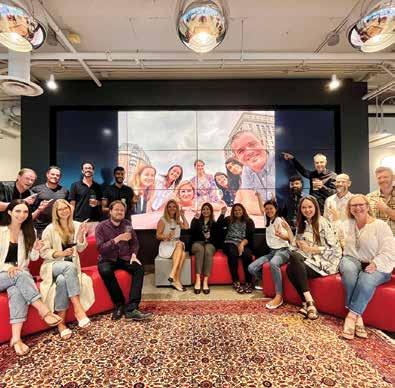


MMCCANN HEALTH CANADA PRESIDENT NEILL BROWN believes it’s what’s inside that counts. That’s why, he explains, the agency has been reflecting on what its employees want as it strives to create the workplace of the future. At the same time, it's been studying the mindset of its target audiences to ensure the messages they receive are appropriate and relevant.
He says that in the wake of the pandemic, “the credibility of the messenger is probably under more scrutiny than ever when it comes to health. Our role as healthcare marketers is to ensure the information we’re communicating is done at an appropriate level of health literacy and through credible, authoritative channels. Evidence-based medicine is where we live.”
To gather insights, McCann Health has for a second year partnered with CRC Research to speak with 100 healthcare professionals across the country. The resulting study found COVID-19 exposed flaws in our healthcare system and caused many to question its long-term viability. Only 62% would encourage their children to follow in their footsteps and only 3% are strongly
Top: The McCann Health Canada team. Right: 1 McCann Health helps ViiV Healthcare Canada create campaigns for therapies as diverse as patients’ needs. 2 The agency worked with Alcon on developing an integrated campaign for Systane eye drops, including this timely OOH offering encouraging dry-eye sufferers to seek relief. 3 McCann Health partnered with CRC Research to conduct a proprietary study involving 100 healthcare professionals across Canada to help better understand the new challenges they face. 4 McCann Health supports Dentalcorp in communicating with dental practices to encourage them to partner with the dental service organization.

S 74 | SPONSORED SUPPLEMENT THE PHARMA REPORT
CONTACT: Neill Brown President neill.brown@mccannhealth.com
1
optimistic about the future of healthcare. “Medicine is beginning to lose its halo,” Brown says.
He adds that the pivot by pharma companies to digital-only during the pandemic – when restrictions prevented doctors from meeting sales reps in person – has led to healthcare providers being bombarded with emails they mostly delete.

As a result, McCann Health is focusing on being more respectful of physicians’ limited time, making content more educational and less promotional. “You can’t market as if it’s 2019,” Brown says. “You have to read the room.”

To glean further intel, the agency now has three planners specializing in insight, engagement and science.
The investment and focus on better connection strategies also aligns with McCann Health’s EDI principles, which are ingrained in how the agency develops external work, adds operations director Carly Smith. “Every creative brief must include formal insights into how people and brands can create environments of belonging, connection and shared purpose,” Smith says.
The agency has been simultaneously responding to the changing needs of its teams crafting this next-gen content, as it strives to create the workplace of the future. For one thing, it is offering unlimited vacations. “We value our people’s time – both inside and outside of work. This policy uses trust and accountability to ensure that people can disconnect when they need to,” Brown explains. It has also “normalized flexibility” by allowing employees to come into the office when they wish.
Brown believes a focus on talent creates an environment for
sustainable growth. “That’s how we’ve grown from a small team to about 50 people across Toronto and Montreal while maintaining the mindset of a small agency,” he says.

Case in point, the recent strategy team expansion saw the internal hire of a medical copywriter who wanted to move over to that side of the industry. Career path moves help drive retention, notes Richelle Colbear, VP, client services, noting that McCann Health has an industry-low turnover of less than 3% and was named to the 2022 list of Best Workplaces in Professional Services in an independent analysis by Great Places to Work. McCann Health’s approach to investing in customer insights and agency talent seems to be resonating with the pharma, consumer health, nutrition, and animal health brands that work with them, as evidenced by newly won business with Sanofi and Nestlé Nutrition, and expanded work with existing clients Roche and Lilly.
And the creativity of that work continues to expand. At a recent medical conference, McCann Health created a booth for a pharma brand that employed anaglyph (or stereoscopic) 3D effects, using a colour filter to clarify confusing messages on a wall. “The anaglyph became a visual metaphor for how people can cut through complexity with the right tool,” says executive creative director Sean Riley.
McCann Health maintains that it is deeply invested in understanding what makes people tick – both its target audiences and its staff. Acting on these insights, Brown sums, “is how we plan to navigate a new era of agency life and healthcare marketing.”



S75
4 3 2
Mastering DTC
AAN AGENCY THAT CALLS ITSELF “THE OUTPOST OF advertising” has figured out how to do work that resonates in the heavily regulated direct-to-consumer (DTC) advertising category for prescription medicines.
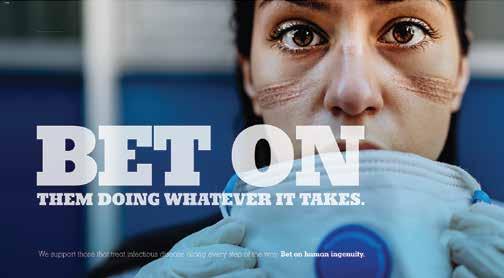
An effective DTC campaign “has to lean into the condition,” says Paul Hickey, president of Peterborough, Ontario-based Outpost379. “The audience has to see themselves in the work.”
Specializing in this area for 17 years, Outpost379 has crafted campaigns that have stood the test of time. And that can be challenging given that in most cases the condition being treated can't be named, as per Canadian DTC advertising regulations.
One of Outpost379's most memorable campaigns has been for Dukoral, a vaccine to prevent travellers’ diarrhea. The “Keep Up with the Joneses” campaign contrasts happy vacationers who took the preventative treatment with miserable ones who did not.
Meanwhile, Danish-based multinational Novo Nordisk, which has a self-described mission to “drive change to defeat diabetes,” engaged Outpost379 for a campaign that not only celebrated the 100th anniversary of the discovery of insulin in Canada, but also promoted the notion that the work the pharmaceutical company is doing today will have a similarly positive impact on the next century.
Outpost379’s work for Gilead includes the unbranded “Back to” campaign that was a response to research that showed many people living with HIV were not engaging with their physician during the pandemic as much as before. The campaign
Left: Outpost379 worked with Gilead early in the pandemic to be in market with “Bet on Them,” showing support for infectious disease physicians and nurses in the fight against COVID-19.
encouraged them to return to taking charge of their health and book an appointment.
“It was the category leader reminding patients that as their world returned to normal, don’t forget to keep on top of your HIV – re-engage with your healthcare providers, including clinics, labs and pharmacies,” Hickey says.
He sees driving consumer demand for Rx brands as a major source of growth for Big Pharma, adding that the opportunity to be first in a category to invest heavily in consumer communication can pay bigger dividends that continually chasing physicians for share gains.
Hickey launched his firm as BrandHealth in his hometown of Peterborough in 2005 but in 2019 changed its name to Outpost379, a tongue-in-cheek reference to the agency’s presence outside of Toronto. (379 is its address on George Street North).
The agency has 27 staffers who have cut their teeth at healthcare and consumer agencies around North America.

It has expanded to take on non-pharma work that still has health, wellness and betterment at its core, including the YMCA of Greater Toronto and the governments of Ontario and Prince Edward Island.
And it has been hiring talent from outside pharma circles, including VP client services Jenni Cowdy, who was brought in last year after working at John St. for clients including KFC and Tangerine and who is now heading up the Toronto Y account.
Other notable hires include new creative director Ben Steele, formerly with Grip; Scott Cosgrove, media director, formerly with UM; and Zac Durisko, previously with Klick, who was tapped as director, medical strategy.
In the interests of refreshing the client relationship, Outpost379 has created a proprietary planning process it calls Idea Lodge, which gathers agency and client at a Kawartha Lakes cabin for a two-day immersive planning session. The notion is that people do great thinking in a summer-camp-like setting.
“You go into it with clear objectives and come out with a strategic foundation for a brand,” Hickey says. “It leads to some very good work.”
Hickey believes clients outside pharma respect the agency’s health roots, and “based on our track record of changing consumer behaviour in challenging areas like HIV, IBD [Crohn’s disease and colitis] and Multiple Sclerosis, see us as well-equipped to tackle tough, important problems of many kinds.”
S 76 | SPONSORED SUPPLEMENT THE PHARMA REPORT
Outpost379’s expertise in direct-to-consumer marketing has wide brand appeal
Left: 1 The isolation caused by the pandemic put HIV patients behind in their regular doctor check-ups. The approach for the “Back to” campaign was to play off activities with which the audience was more excited about re-engaging. 2 This campaign for Novo Nordisk, a global leader in the battle against diabetes, speaks to a future of further amazing discoveries.
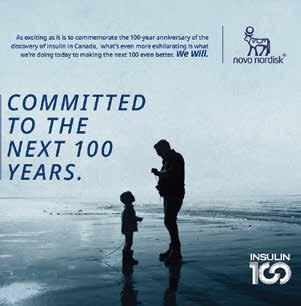

3 Outpost379’s Idea Lodge planning model consists of a two-day, immersive experience at the agency’s cabin north of Peterborough, inspired by the positive energy, relaxation, and clear thinking that happens at a cottage or summer camp. 4 As creative and media AOR for the YMCA of Greater Toronto, Outpost379’s latest campaign is aimed at improving understanding of the YMCA’s many programs and community services that can help support anyone reaching their full potential. 5 Broadcast work for Dukoral contrasted the plight of a family stuck in their hotel room with traveller’s diarrhea to a family that prepared by taking the vaccine ahead of time.
 CONTACT: Paul Hickey President paul.hickey@outpost379.com
CONTACT: Paul Hickey President paul.hickey@outpost379.com



S77
5 1 2 4 3
Redefining what an agency can offer
Newly independent Fisika leans into the future
[physicians] become more efficient.”
Fisika’s USP is its knack for simplifying complex information, which it refers to as the “art of clarity.” That’s why the shop formerly known as CDM Montreal opted for its new name in June. In Greek, “fisika” means something that comes naturally.
The rebranding came more than two years after the partners acquired the full-service agency.

Although they signed the purchase papers three weeks before the initial COVID-19 lockdown, they went on to win business in virtual pitches. Major clients include Novartis, Bristol Myers Squibb, Pfizer and U.S. medical device companies.
With an eye for the future, Fisika still prides itself in delivering high-quality strategy and creative that gets noticed, which are mainstays of an agency.
FFROM CREATING SOFTWARE TO optimizing electronic medical records (EMRs), Montreal healthcare marketing and advertising agency Fisika is finding new ways to solve problems in a changing pharma world.
Above: From left, Fisika partners Priscilla Benfeito, Anna Tsouluhas and Lisa Barbusci.
Over the past few years, Fisika has won more than 25 Rx Club Show awards celebrating international creative, which Benfeito says wasn’t easy.
“We just made it look easy,“ she says.
“Impactful creative begins with a synthesized and clear strategy,“ Tsouluhas adds. “And we make it look like it comes naturally,“says Barbusci.
“There is a lot of value in the traditional work of an agency, but we need to evolve and expand to be able to meet where we believe the industry is headed,” says Lisa Barbusci, a partner in Fisika along with Priscilla Benfeito and Anna Tsouluhas. And that means taking different approaches than the ones usually taken.

Case in point: Fisika has developed a software as a medical device. What started as a need to support healthcare professionals (HCPs) to train patients with respiratory problems on how to use their inhaler device turned into a patented Fisika-owned software.
With the software, HCPs will be able to use the patients’ smartphone microphone to assess their ability to inhale. This helps train patients and can even help decide what device is best for them. Called Alaré – based on the Italian word for inhale – it is soon to be tested in a clinical trial and submitted to Health Canada for approval.
Given that EMRs are now a reality in Canada, Fisika has hired an EMR integration manager to improve the system integration and utilization. This allows Fisika to help clients collaborate with physicians to improve efficiency and communication with patients. Fisika is currently in pilot projects with several clients.
“This breaks new ground,” Tsouluhas says. “Finding creative ways to utilize the EMR system will be critical to helping
A multiple-award-winning campaign for Otsuka that continues to be used today is for a treatment that gives voice to chronic kidney disease patients. Since patients with the condition often say they don’t feel seen or heard, the agency conveyed that invisibility insight via creative that saw patients blending into the background.
The aim was to tell healthcare professionals, “It’s time to see the person behind the condition.”
Most recently, Fisika’s own branding – including its website, logo and intro video – won four Rx awards.
The agency also does non-profit work, which has included launching the Program for Women’s Cancer Research (PWR). The initiative from McGill University aims to improve cure rates for women with cancer and has found a partner in La Grande Roue de Montréal Ferris wheel. The inaugural September 2021 event raised more than $150,000 and attracted La Roche-Posay as the organization’s title sponsor for its second year.
Fisika recently bought an open-concept property in Montreal’s Little Italy-Mile Ex area which the partners believe is conducive to creative thinking. Its employees – a mix of new talent and agency veterans – can work there or from home.
Benfeito explains, “We want to make sure people are having fun and are able to disconnect so that they come back and want to give their best.”
S 78 | SPONSORED SUPPLEMENT THE PHARMA REPORT
Clockwise: 1 This origami image of La Grande Roue de Montréal was part of a promotional campaign for a fundraising event aboard the Ferris wheel on behalf of the Program for Women’s Cancer Research. 2 Fisika’s social media DTC campaign for Emerade features an anamorphic video creating awareness for a new epinephrine auto-injector. Simple and eye-catching, it helped the client increase visibility and click-through rates. 3 Working on a campaign for a new treatment option from pharma firm Otsuka, Fisika blurred an image of a person with a background paisley texture to underscore that kidney disease patients feel they are not being seen or heard. 4 Fisika took the lead on the global launch of Johnson & Johnson’s VistaSeal, which helps control bleeding in adults undergoing surgery. The campaign features intricate, representative imagery and a key message that depicts a real and relevant benefit to the end user – surgeons.
 Lisa Barbusci Partner
Lisa Barbusci Partner





CONTACT:
lisa@fisika.ca S79
4 3 1 2
Iconic strategies: the insights (& secret sauce) behind Canada’s stand-out marketing moves

This year’s Strategy Awards demonstrate the power of marketing to effect real change and upend the way consumers think. Whether that’s giving Sikh riders a safe way to hit the open road or giving voice to communities that have been left out, the plans and programs Canada’s top marketers and CSOs chose as the best of the year prove that marketing powered by insights, data and heart will rise above. Here, we highlight the strategic nuggets that made these ideas Gold-worthy.
Pride is a time of celebration, but that can mask the reality and need for Fondation Émergence’s mission. To viscerally convey that behind the floats and parades LGBTQ2+ communities still face persecution, the org and Rethink focused on the ongoing violence that exists by reinterpreting the pride flag to include colours of the bruises and injuries suffered by victims. “Colours of Pride” was launched with a video that introduced the flag, featuring prominent names who had experienced hate crimes. Seeded across Émergence’s social platforms and amplified by key allies, it generated record site visits (+40% YOY), toolkit orders (+8%), requests for interviews (X2) and donations (+15%). Émergence’s social channels grew by more than 150%, while the video generated more than 2.4 million views. Now the symbol of Pride also serves as a reminder of the darker realities faced by many in the communities it champions.

While Décathlon is new to the crowded Canadian sports scene, the retailer has a long global history of championing “sports for all.” So the brand decided to lead with its accessibility focus as the USP that would build awareness around ambitious national expansion plans. Décathlon and Rethink decided to show rather than tell, using iconography to embody the brand ethos. They reimagined store signage by transforming the universally-recognized wheelchair sign into “Ability Signs” – 25 custom symbols depicting prowess in different sports. The concept was embraced by Décathlon’s international stakeholders, accessibility advocates and media –reaching 73 countries, earning 227 million organic impressions and realizing a 439% increase in brand mentions. The Canadian-born advocacy program was the most shared social campaign in Décathlon’s history.
PS GRAND PRIX

Outmigration is a fact of life Down East. “Come Home 2022” was a program aimed at reversing that trend. While Newfoundland and Labrador Tourism and Target knew it couldn’t capture the Maritimes’ diaspora with one campaign, it could get the word out by targeting friends and family back home. The strategy delivered 10.4M media impressions, and 250,000+ social engagements. Most importantly, expats started to come home. Ferry bookings aboard Marine Atlantic went up 16% versus 2019.
Check out more of Canada’s strategic coups at strategyawardwinners. strategyonline.ca/2022
80 strategyonline.ca
Canada’s top insect repellent brand, Wilson, wanted to disrupt the category and stay ahead of the competition. So, working with Touché!, the partners built a data ecosystem that allowed them to predict which insects were more prone to infest according to different weather triggers. Using data, they mapped the most infected neighbourhoods across Canada and created firstto-market audience targeting to connect with people based on their postal code-calculated bug match. “Bugs Out!” spurred a global sales increase of 2.5% in the pest control category and outperformed on click-through rates. Some of the creative realized up to five times over the anticipated results.

St. John’s Board of Trade wanted to remind residents in Newfoundland to shop local. So, it partnered with Target on a new way to make that now-familiar plea resonate. They dug into niche local insights to come up with “Don’t Get Dieppe’d” – a turn of phrase referencing the infamous shipping locale where inbound packages often disappear. Touting the benefits of avoiding that risk by shopping local, the campaign hit during key fall online shopping periods. The campaign earned more than 97,000 video views on social media, 1.05 million ad impressions, 1,570 ad clicks and CTR 31% higher than the benchmark. No metrics on how many lost parcels were averted.
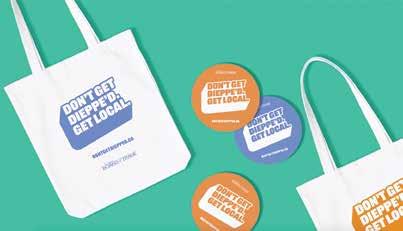
Whether it’s funding or TV slots, the sports world focuses on male athletes and treats women as secondary. Rethink and YWCA tackled the disparity by challenging the most commonplace way the distinction manifests – the “W” added to any women’s league. To point out the inequity, the partners added an “M” to four major league men’s sports logos, and left it to the internet to fuel dialogue. Endorsed by soccer star Christine Sinclair, “Add the M” was launched on YWCA social channels across Canada. It made headlines across the globe in over 170 publications, achieving an overall reach of more than 102 million impressions and an earned media value over 46,000% above investment.



Girl Guides of Canada (GGC) and Zulu Alpha Kilo wanted to address the attendance hit the non-profit suffered during the pandemic, as well as the perception that The Guides were behind the times. So, the partners turned campfire songs into Girl Guides “Fire Songs,” each an anthem intended to inspire girls. “Fire Songs” boosted interest in membership, achieving a 28% lift in site traffic and an 89% lift to the Join Us page, year over year. Perceptions changed in Canadian parents of girls: 83% saw GGC in a new way, 84% felt it was more modern, 85% felt it helps empower girls, and 88% were more open to their daughter participating.
Lottery’s player base is aging out – only 14% of players are under the age of 35. So, OLG and FCB created the young adult-targeted “Dream Drop” clothing line. Each offering in the collection was scannable like a real lottery ticket and good for one $5 Lotto Max ticket per week for a year. The launch was covered by fashion bloggers and influencers, and a Toronto Raptors NBA player modeled the clothing. It saw a 40% increase in positive perception of the brand (doubling the objective), as well as a 194% lift in account registrations. Most importantly, it got 18- to 35-year-olds to play, with a 200% lift in ticket sales over the first three weeks.
81Fall 2022
The goal was to get North Americans to publicly declare their love for Heinz Ketchup during BBQ season. So, Kraft Heinz and Rethink keyed in on the most contentious theme they could think of: that hot dogs are sold in packs of 10 while buns only come in packs of eight. It all started with a launch video calling on consumers to take action by signing on Change.org (with more than 15,000 signatures in the first 24 hours).
“Hot Dog Pact” hit a whopping $13MM in earned media and had over 1.2 billion earned impressions. Overall sales were up 2.3% from 2019 and the brand saw a 1% increase in share within the Ketchup category. As for the uneven hot dog and bun situation: mission accomplished.


BMO and FCB Montreal wanted to tear down one of the primary barriers to youth participation in sports – the cost of equipment. So, they launched a drive in Greater Montreal revolving around the city’s MLS franchise, encouraging people to donate. “Gear Up” not only collected and cleaned more than 10,000 pieces of equipment, an e-com site was built to showcase the refurbished gear so kids could order what they wanted gratis. Packages wrapped boutique-style were delivered to 2,500 kids, cementing the bank’s soccer sponsorship presence.
Finding a favourite chocolate in an assorted box is a challenge for 23 million blind or partially sighted North Americans. To address this (and stand out from the holiday chocolate crowd), Purdys and Rethink designed the “Holiday Braille Box,” a fully accessible box that featured Braille orientation tabs and legend, as well as a QR code for an audio version. It received nationwide coverage, with earned media topping out at 395X the initial investment.

Harley-Davidson wanted to make sure the open road was accessible for everyone – and also change perceptions of the brand and who Harley riders are. That’s why Pfaff Harley-Davidson and Zulu Alpha Kilo created “Tough Turban,” a helmet made from fabric, Dyneema and non-Newtonian foam, which allowed Sikh riders to take to the road safely. Media response to the campaign was huge – with 238.8 million earned impressions. Research also showed a significant shift in perception: 87% saw Harley-Davidson as more favourable, 86% as more innovative and 83% as more inclusive.


The well-loved Remembrance Day poppy turns 100 this year. To honour it and preserve each soldier’s memory in a way that would also bring a younger demographic into the poppy-buying fold, the Royal Canadian Legion and Wunderman Thompson created the “Immortal Poppy” – a digital replica that features the names of all 118,000 fallen Canadians on its petals and the walls of a virtual cenotaph. Their names and memory are now forever linked to the blockchain, eternally preserving them in the form of 100 collectible NFT poppies. Each NFT perpetually raises funds for the Royal Canadian Legion every time it is sold or resold, making the giving immortal, too. It’s an act of remembrance guaranteed to last beyond the next 100 years.
IKEA is all-in on sustainability, but finding new ways to engage consumers in that journey isn’t easy. When Cristiano Ronaldo made headlines during a press conference at Euro 2020 by pushing away the Coca-Cola bottles in front of him to hold up a bottle of water instead, IKEA and Rethink saw the perfect opportunity to hijack the conversation to make it about the brand’s reusable water bottle. The partners blasted posts across social, resulting in 700 million earned impressions in 48 hours and $25 million in paid media value. It was the brand’s most talked about post ever and, though not an advertiser, IKEA became the second-most talked about brand of the tournament.

82 strategyonline.ca
Bernbach Ogilvy Wieden Jancy




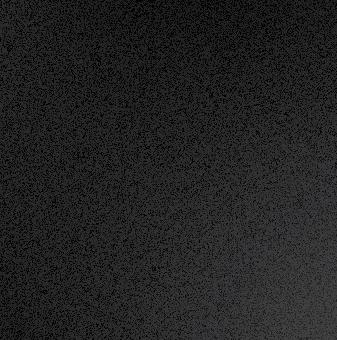
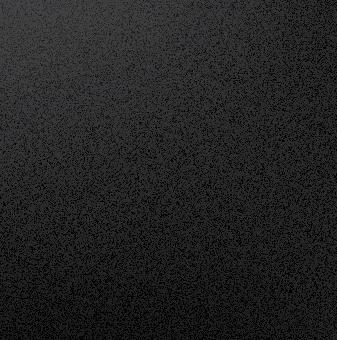


Congratulations, Janet & Nancy, on being inducted into The One Club Creative Hall of Fame. You’ve made the entire Canadian industry proud. From your friends at Zulu Alpha Kilo.










THE MEDIA MOMENTS THAT MADE IMPRESSIONS mediainnovationawards.strategyonline.ca FRIDAY, DECEMBER 2 THE CARLU, TORONTO BOOK YOUR TABLE






































 BY CHELSEA CLARKE
BY CHELSEA CLARKE














































 BY JUSTIN CRANN
BY JUSTIN CRANN
































 BY NICK KREWEN
BY NICK KREWEN


















 BY PATTI SUMMERFIELD
BY PATTI SUMMERFIELD
















 BY PATTI SUMMERFIELD
BY PATTI SUMMERFIELD











 BY CHELSEA CLARKE
BY CHELSEA CLARKE



























 CONTACT: Paul Hickey President paul.hickey@outpost379.com
CONTACT: Paul Hickey President paul.hickey@outpost379.com




 Lisa Barbusci Partner
Lisa Barbusci Partner



































